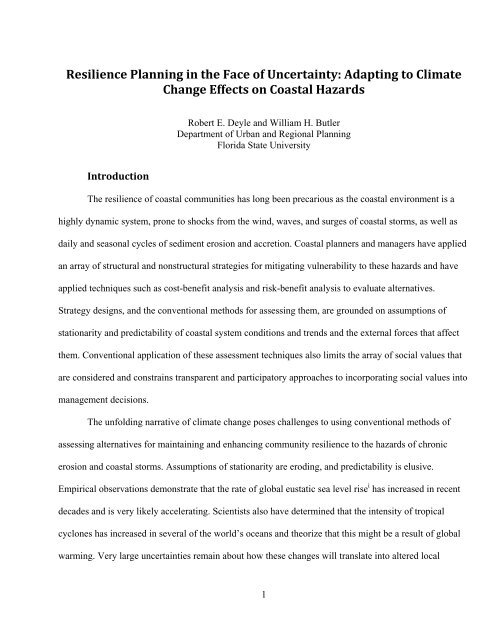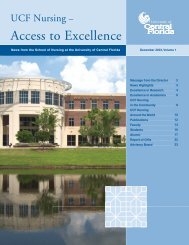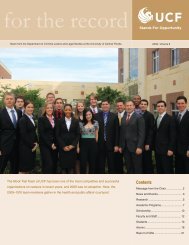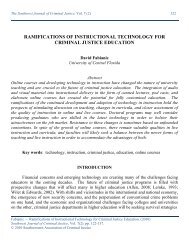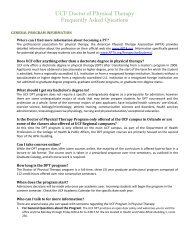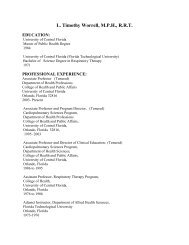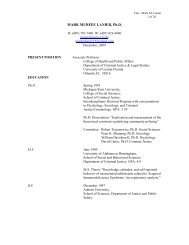Resilience Planning in the Face of Uncertainty: Adapting to Climate ...
Resilience Planning in the Face of Uncertainty: Adapting to Climate ...
Resilience Planning in the Face of Uncertainty: Adapting to Climate ...
You also want an ePaper? Increase the reach of your titles
YUMPU automatically turns print PDFs into web optimized ePapers that Google loves.
<strong>Resilience</strong> <strong>Plann<strong>in</strong>g</strong> <strong>in</strong> <strong>the</strong> <strong>Face</strong> <strong>of</strong> Uncerta<strong>in</strong>ty: Adapt<strong>in</strong>g <strong>to</strong> <strong>Climate</strong><br />
Change Effects on Coastal Hazards<br />
Robert E. Deyle and William H. Butler<br />
Department <strong>of</strong> Urban and Regional <strong>Plann<strong>in</strong>g</strong><br />
Florida State University<br />
Introduction<br />
The resilience <strong>of</strong> coastal communities has long been precarious as <strong>the</strong> coastal environment is a<br />
highly dynamic system, prone <strong>to</strong> shocks from <strong>the</strong> w<strong>in</strong>d, waves, and surges <strong>of</strong> coastal s<strong>to</strong>rms, as well as<br />
daily and seasonal cycles <strong>of</strong> sediment erosion and accretion. Coastal planners and managers have applied<br />
an array <strong>of</strong> structural and nonstructural strategies for mitigat<strong>in</strong>g vulnerability <strong>to</strong> <strong>the</strong>se hazards and have<br />
applied techniques such as cost-benefit analysis and risk-benefit analysis <strong>to</strong> evaluate alternatives.<br />
Strategy designs, and <strong>the</strong> conventional methods for assess<strong>in</strong>g <strong>the</strong>m, are grounded on assumptions <strong>of</strong><br />
stationarity and predictability <strong>of</strong> coastal system conditions and trends and <strong>the</strong> external forces that affect<br />
<strong>the</strong>m. Conventional application <strong>of</strong> <strong>the</strong>se assessment techniques also limits <strong>the</strong> array <strong>of</strong> social values that<br />
are considered and constra<strong>in</strong>s transparent and participa<strong>to</strong>ry approaches <strong>to</strong> <strong>in</strong>corporat<strong>in</strong>g social values <strong>in</strong><strong>to</strong><br />
management decisions.<br />
The unfold<strong>in</strong>g narrative <strong>of</strong> climate change poses challenges <strong>to</strong> us<strong>in</strong>g conventional methods <strong>of</strong><br />
assess<strong>in</strong>g alternatives for ma<strong>in</strong>ta<strong>in</strong><strong>in</strong>g and enhanc<strong>in</strong>g community resilience <strong>to</strong> <strong>the</strong> hazards <strong>of</strong> chronic<br />
erosion and coastal s<strong>to</strong>rms. Assumptions <strong>of</strong> stationarity are erod<strong>in</strong>g, and predictability is elusive.<br />
Empirical observations demonstrate that <strong>the</strong> rate <strong>of</strong> global eustatic sea level rise i has <strong>in</strong>creased <strong>in</strong> recent<br />
decades and is very likely accelerat<strong>in</strong>g. Scientists also have determ<strong>in</strong>ed that <strong>the</strong> <strong>in</strong>tensity <strong>of</strong> tropical<br />
cyclones has <strong>in</strong>creased <strong>in</strong> several <strong>of</strong> <strong>the</strong> world’s oceans and <strong>the</strong>orize that this might be a result <strong>of</strong> global<br />
warm<strong>in</strong>g. Very large uncerta<strong>in</strong>ties rema<strong>in</strong> about how <strong>the</strong>se changes will translate <strong>in</strong><strong>to</strong> altered local<br />
1
exposure and associated vulnerability and, <strong>in</strong> fact, those uncerta<strong>in</strong>ties are <strong>in</strong>determ<strong>in</strong>ate. Scientists are<br />
unable <strong>to</strong> estimate objective probabilities for how high sea level will get, where, and when, or how more<br />
frequently higher-<strong>in</strong>tensity hurricanes will occur.<br />
The capacity <strong>to</strong> adapt <strong>in</strong> <strong>the</strong> face <strong>of</strong> chang<strong>in</strong>g system dynamics is essential for community<br />
resilience <strong>to</strong> coastal hazards (Adger et al., 2005; Beatley, 2009; U.S. Indian Ocean Tsunami Warn<strong>in</strong>g<br />
System Program, 2007; Walker et al., 2004). Thus, coastal communities need a different approach for<br />
analyz<strong>in</strong>g alternatives and choos<strong>in</strong>g responses where uncerta<strong>in</strong>ty is <strong>in</strong>determ<strong>in</strong>ate and where <strong>the</strong>y wish <strong>to</strong><br />
apply broader goals <strong>to</strong> assess<strong>in</strong>g alternatives <strong>in</strong> a transparent and participa<strong>to</strong>ry manner. The practices <strong>of</strong><br />
adaptive management and scenario analysis can provide <strong>the</strong> means <strong>to</strong> identify, select, and adopt robust<br />
and flexible mitigation measures that promote resilience while cop<strong>in</strong>g with uncerta<strong>in</strong>ty <strong>in</strong> complex and<br />
dynamic social-ecological systems.<br />
In this chapter, we explore how small and rural coastal communities can effectively address <strong>the</strong><br />
challenges that confront <strong>the</strong>m as <strong>the</strong>y attempt <strong>to</strong> build <strong>the</strong> resilience with limited economic and human<br />
capital. We <strong>in</strong>troduce a decision <strong>to</strong>ol based on Hill’s (1968) goals achievement matrix (GAM) and<br />
demonstrate how it can be used <strong>to</strong> support complex alternatives analysis under <strong>in</strong>determ<strong>in</strong>ate uncerta<strong>in</strong>ty.<br />
We also show how communities can build <strong>the</strong>ir adaptive capacity by us<strong>in</strong>g such a <strong>to</strong>ol <strong>in</strong> an adaptive<br />
governance framework that facilitates social learn<strong>in</strong>g and collaborative management.<br />
We beg<strong>in</strong> this chapter by contrast<strong>in</strong>g conventional views <strong>of</strong> resilience with <strong>the</strong> concept <strong>of</strong><br />
adaptive resilience that recognizes that most social-ecological systems do not exist <strong>in</strong> a state <strong>of</strong> dynamic<br />
equilibrium. Then, we explore how <strong>the</strong> context <strong>of</strong> coastal management is chang<strong>in</strong>g <strong>in</strong> <strong>the</strong> face <strong>of</strong><br />
accelerat<strong>in</strong>g sea-level rise and <strong>the</strong> possibility <strong>of</strong> <strong>in</strong>creas<strong>in</strong>g <strong>in</strong>tensities <strong>of</strong> tropical cyclones. Next, we<br />
elaborate on <strong>the</strong> short-com<strong>in</strong>gs <strong>of</strong> conventional approaches <strong>to</strong> alternatives analysis, and make our case for<br />
adaptive management and scenario analysis as more effective for deal<strong>in</strong>g with complexity and<br />
2
uncerta<strong>in</strong>ty. We <strong>the</strong>n <strong>in</strong>troduce Hill’s GAM and show how it can be applied <strong>to</strong> <strong>the</strong> particulars <strong>of</strong> adapt<strong>in</strong>g<br />
<strong>to</strong> <strong>the</strong> effects <strong>of</strong> climate change on coastal hazards. We conclude by outl<strong>in</strong><strong>in</strong>g <strong>the</strong> elements <strong>of</strong> an adaptive<br />
governance process through which collaborative, social learn<strong>in</strong>g can be <strong>in</strong>corporated <strong>in</strong><strong>to</strong> iterative and<br />
ongo<strong>in</strong>g use <strong>of</strong> a GAM as new knowledge and chang<strong>in</strong>g understand<strong>in</strong>gs, values, and perceptions are<br />
<strong>in</strong>corporated <strong>in</strong><strong>to</strong> climate change adaptation responses.<br />
<strong>Resilience</strong> and Coastal Hazards Management<br />
The conventional approach <strong>to</strong> hazard mitigation and post-disaster redevelopment conceives <strong>of</strong><br />
resilience as <strong>the</strong> ability <strong>of</strong> a physical or social system <strong>to</strong> recover from <strong>the</strong> major disturbance <strong>of</strong> a natural<br />
disaster. This so-called “eng<strong>in</strong>eer<strong>in</strong>g resilience” presumes stability <strong>of</strong> system structure and function<br />
centered on some optimal equilibrium. It is measured by <strong>the</strong> time necessary <strong>to</strong> repair or rebuild <strong>the</strong><br />
impacted elements <strong>of</strong> <strong>the</strong> system and <strong>to</strong> res<strong>to</strong>re its normal structure and functions (Folke 2006, p. 256;<br />
Zellner et al., 2011, p. 45); hence <strong>the</strong> conventional goal <strong>of</strong> post-disaster recovery <strong>to</strong> “return <strong>to</strong> normal as<br />
quickly as possible” (Schwab et al., 1998).<br />
Scholars have begun <strong>to</strong> understand that stability is an elusive state for complex social-ecological<br />
systems that are subject <strong>to</strong> periodic acute perturbations, such as natural hazards and economic shocks,<br />
and slow-mov<strong>in</strong>g chronic changes, such as shift<strong>in</strong>g demographic patterns and climate change which<br />
repeatedly and cont<strong>in</strong>uously alter system conditions and dynamics (Walker & Salt, 2006, p. 10). In this<br />
view, <strong>the</strong> system’s resilience is not its ability <strong>to</strong> bounce back <strong>to</strong> a previous equilibrium po<strong>in</strong>t. Ra<strong>the</strong>r it is<br />
<strong>the</strong> ability <strong>of</strong> system relationships and functions <strong>to</strong> persist, perhaps <strong>in</strong> an altered state, <strong>in</strong> a new context<br />
(Boyd & Folke, 2012, p. 2; Holl<strong>in</strong>g, 1973, p. 17). This mode <strong>of</strong> resilience, which has been dubbed by<br />
some as “adaptive resilience” (Ali et al., 2011; Rob<strong>in</strong>son, 2010), depends upon a system’s “adaptive<br />
capacity,” that is, its ability <strong>to</strong> “modify or change its characteristics or behaviour so as <strong>to</strong> cope better with<br />
exist<strong>in</strong>g or anticipated external stresses” (Adger et al., 2004, p. 34).<br />
3
Adger et al. (2005, p. 1036), cit<strong>in</strong>g Carpenter et al. (2001) and Folke (2002), argue that such<br />
resilience is <strong>in</strong> part a function <strong>of</strong> <strong>the</strong> ability <strong>of</strong> <strong>the</strong> system <strong>to</strong> “build capacity for learn<strong>in</strong>g.” Such learn<strong>in</strong>g<br />
is especially critical where planners and managers face uncerta<strong>in</strong>ty about how social-ecological systems<br />
work, how <strong>the</strong>y are affected by external perturbations and management <strong>in</strong>terventions, and how external<br />
drivers are chang<strong>in</strong>g.<br />
Scholars who have exam<strong>in</strong>ed <strong>the</strong> capacity <strong>of</strong> communities <strong>to</strong> adapt <strong>to</strong> climate change have<br />
determ<strong>in</strong>ed that this capacity is a function <strong>of</strong> human and social capital, as well as economic capital, and is<br />
uneven across communities, even with<strong>in</strong> developed countries (Adger et al., 2007, pp. 728-729).<br />
Important fac<strong>to</strong>rs <strong>in</strong>clude education, <strong>in</strong>come, and health, local economic development, and access <strong>to</strong><br />
technology, as well as government <strong>in</strong>stitutions, community organizations, and social networks (Adger &<br />
V<strong>in</strong>cent, 2005; Adger et al., 2004; Yohe & Tol, 2002). Adaptive capacity <strong>in</strong> small and rural coastal<br />
communities is constra<strong>in</strong>ed by limited resources on which <strong>to</strong> draw <strong>to</strong> undertake plann<strong>in</strong>g and implement<br />
management actions. Thus, smaller coastal cities and rural communities are likely <strong>to</strong> have less capacity <strong>to</strong><br />
adapt <strong>to</strong> <strong>the</strong> added complexities and uncerta<strong>in</strong>ties that climate change br<strong>in</strong>gs <strong>to</strong> manag<strong>in</strong>g coastal hazards<br />
resiliently. It is <strong>to</strong> <strong>the</strong>se uncerta<strong>in</strong>ties and complexities <strong>in</strong> coastal climate change adaptation that we now<br />
turn our attention.<br />
Uncerta<strong>in</strong> complex hazards<br />
The equilibrium resilience assumptions <strong>of</strong> conventional coastal hazard mitigation along<br />
sedimentary coasts reflect <strong>in</strong> part implicit or explicit assumptions that <strong>the</strong> external drivers <strong>of</strong> chronic<br />
erosion and s<strong>to</strong>rm forces are stationary phenomena: chronic erosion rates are driven by a constant rate <strong>of</strong><br />
sea level rise and coastal s<strong>to</strong>rms have return frequencies that can be ascerta<strong>in</strong>ed by analyz<strong>in</strong>g his<strong>to</strong>ric<br />
data. Thus coastal communities have sought <strong>to</strong> reduce <strong>the</strong>ir vulnerability <strong>to</strong> <strong>the</strong>se hazards through such<br />
strategies as construct<strong>in</strong>g s<strong>of</strong>t (beach nourishment) and hard (bulkheads, revetments, seawalls)<br />
4
eng<strong>in</strong>eered structures designed <strong>to</strong> withstand s<strong>to</strong>rms with specified return frequencies. They similarly<br />
adopt build<strong>in</strong>g elevation standards and policies for restrict<strong>in</strong>g development <strong>of</strong> <strong>the</strong> most hazardous areas<br />
based on maps <strong>of</strong> w<strong>in</strong>d zones, flood hazard areas, and s<strong>to</strong>rm surge flood zones with specified return<br />
frequencies. And some communities def<strong>in</strong>e fixed-distance development setbacks based on a reference<br />
feature such as <strong>the</strong> mean high tide l<strong>in</strong>e or some multiple <strong>of</strong> <strong>the</strong> average annual erosion rate.<br />
<strong>Climate</strong> change, however, confronts coastal planners with two dimensions <strong>of</strong> uncerta<strong>in</strong>ty as <strong>the</strong>y<br />
attempt <strong>to</strong> ma<strong>in</strong>ta<strong>in</strong> or enhance <strong>the</strong> resilience <strong>of</strong> <strong>the</strong>ir communities over plann<strong>in</strong>g horizons <strong>of</strong> multiple<br />
decades:<br />
1. knowledge <strong>of</strong> <strong>the</strong> future trends <strong>of</strong> <strong>the</strong> external drivers <strong>of</strong> physical and ecological coastal systems<br />
and how those systems will adjust au<strong>to</strong>nomously and<br />
2. knowledge <strong>of</strong> <strong>the</strong> current and future goals and priorities <strong>of</strong> <strong>the</strong> stakeholders who comprise <strong>the</strong><br />
social systems for which <strong>the</strong>y plan.<br />
The uncerta<strong>in</strong>ties about future trends <strong>of</strong> <strong>the</strong> external drivers <strong>of</strong> sea level rise rates and tropical cyclone<br />
<strong>in</strong>tensity are currently <strong>in</strong>determ<strong>in</strong>ate, a function <strong>of</strong> all three dimensions <strong>of</strong> what <strong>the</strong> U.S. Army Corps <strong>of</strong><br />
Eng<strong>in</strong>eers def<strong>in</strong>es as “knowledge uncerta<strong>in</strong>ty”: “<strong>in</strong>complete understand<strong>in</strong>g <strong>of</strong> . . . [<strong>the</strong>] system, model<strong>in</strong>g<br />
limitations, and . . . limited data” (USACE, 2011, p. 10). Until recently, <strong>the</strong> rate <strong>of</strong> global eustatic sea<br />
level rise has been quite modest, approximately 1.8 mm/year (Meehl et al., 2007). As sea level rises,<br />
sedimentary shorel<strong>in</strong>es recede from <strong>the</strong> comb<strong>in</strong>ed effects <strong>of</strong> erosion and <strong>in</strong>undation. Reced<strong>in</strong>g shorel<strong>in</strong>es<br />
and higher sea levels also shift coastal flood zones fur<strong>the</strong>r <strong>in</strong>land <strong>the</strong>reby <strong>in</strong>creas<strong>in</strong>g <strong>the</strong> return<br />
frequencies <strong>of</strong> floods <strong>of</strong> a given magnitude at any given location (N<strong>in</strong>g et al., 2012). Coastal planners<br />
have accommodated ris<strong>in</strong>g sea level ei<strong>the</strong>r by ignor<strong>in</strong>g it because <strong>the</strong> rate has been so slow or by<br />
account<strong>in</strong>g for average erosion rates <strong>in</strong> <strong>the</strong> design <strong>of</strong> beach renourishment projects, shore protection<br />
structures, and erosion-based development setbacks.<br />
5
More recent observations <strong>in</strong>dicate, however, that <strong>the</strong> rate <strong>of</strong> global eustatic sea level rise has been<br />
higher s<strong>in</strong>ce at least <strong>the</strong> early 1990s, averag<strong>in</strong>g 3.3 mm/yr between 1993 and 2003 (Meehl et al., 2007).<br />
Both <strong>the</strong>ory and evidence suggest that <strong>the</strong> rate is accelerat<strong>in</strong>g due <strong>to</strong> an array <strong>of</strong> positive global warm<strong>in</strong>g<br />
and sea level rise feedbacks, <strong>the</strong> most prom<strong>in</strong>ent <strong>of</strong> which is accelerated melt<strong>in</strong>g <strong>of</strong> <strong>the</strong> Greenland and<br />
West Antarctic ice sheets (Gr<strong>in</strong>sted et al., 2010; Hansen & Sa<strong>to</strong>, 2011; Pfeffer et al., 2008; Steffen et al.,<br />
2008; Vermeer & Rahms<strong>to</strong>rf, 2009). At present, however, scientists are unable <strong>to</strong> fully expla<strong>in</strong> how and<br />
why <strong>the</strong> ice sheets are melt<strong>in</strong>g more rapidly based on models derived from geologic time scales <strong>of</strong> glacial<br />
changes (Steffen et al., 2008). Add<strong>in</strong>g <strong>to</strong> <strong>the</strong>se uncerta<strong>in</strong>ties are <strong>the</strong> complexities <strong>of</strong> predict<strong>in</strong>g rates <strong>of</strong> sea<br />
level rise <strong>in</strong> particular locations. This local “relative sea level” rise is a function <strong>of</strong> differential <strong>the</strong>rmal<br />
expansion <strong>of</strong> sea water, sal<strong>in</strong>ity, w<strong>in</strong>ds and currents, proximity <strong>to</strong> melt<strong>in</strong>g ice, and <strong>the</strong> direction and rate<br />
<strong>of</strong> land surface movement (Meehl et al., 2007, p. 813).<br />
<strong>Climate</strong> change also is likely <strong>to</strong> affect tropical cyclone activity, add<strong>in</strong>g a second dimension <strong>of</strong><br />
uncerta<strong>in</strong>ty <strong>to</strong> manag<strong>in</strong>g <strong>the</strong> resilience <strong>of</strong> coastal communities. There is some evidence that <strong>in</strong>creases <strong>in</strong><br />
tropical cyclone frequency may have accompanied ris<strong>in</strong>g sea surface temperatures <strong>in</strong> <strong>the</strong> nor<strong>the</strong>rn<br />
Atlantic s<strong>in</strong>ce <strong>the</strong> 1970s (Webster et al., 2005, p. 1844), but not elsewhere. The percentage <strong>of</strong> higher<br />
<strong>in</strong>tensity tropical cyclones, i.e. Category 4 and 5 hurricanes, has apparently <strong>in</strong>creased <strong>in</strong> <strong>the</strong> nor<strong>the</strong>rn<br />
Atlantic and <strong>in</strong> o<strong>the</strong>r oceans (Elsner et al., 2008; Emanuel, 2005, 2007; USEPA, 2010). Uncerta<strong>in</strong>ty<br />
rema<strong>in</strong>s, however, about <strong>the</strong> extent <strong>to</strong> which recent trends are a direct reflection <strong>of</strong> climate change as<br />
opposed <strong>to</strong> o<strong>the</strong>r temporal patterns <strong>in</strong> fac<strong>to</strong>rs that <strong>in</strong>fluence tropical cyclone <strong>in</strong>tensity (Karl et al., 2008, p.<br />
6; USEPA, 2010, p. 32).<br />
Coastal planners and managers also may face knowledge uncerta<strong>in</strong>ty about social goals and<br />
priorities because <strong>of</strong> <strong>the</strong> diversity <strong>of</strong> perceptions and value-based perspectives held by stakeholders about<br />
<strong>the</strong> causes <strong>of</strong> observed changes <strong>in</strong> coastal hazard phenomena and <strong>the</strong> appropriate management responses<br />
6
(Pahl Wostl et al., 2007, p. 32). Uncerta<strong>in</strong>ty <strong>in</strong> <strong>the</strong> social system may arise not only from a lack <strong>of</strong> data or<br />
<strong>in</strong>formation <strong>to</strong> understand <strong>the</strong>se values under current conditions, but also from chang<strong>in</strong>g stakeholder<br />
values and perceptions over time about <strong>the</strong> nature and importance <strong>of</strong> <strong>the</strong> threats posed by climate change<br />
and coastal hazards (NRC, 2004, p. 43).<br />
Conventional decision mak<strong>in</strong>g <strong>in</strong> uncerta<strong>in</strong> environments<br />
Cost-benefit analysis (CBA) is <strong>the</strong> bedrock <strong>of</strong> public-sec<strong>to</strong>r alternatives evaluation <strong>in</strong> <strong>the</strong> U.S.<br />
(USACE, 1983, 2011, 2012) and is widely embraced for assess<strong>in</strong>g climate change adaptation options (see<br />
for example Callaway, 2004; Fankhauser et al., 1999; Smith, 1997; Toman, 2006). The methods for<br />
do<strong>in</strong>g so are complex and data <strong>in</strong>tensive, however, and likely well beyond <strong>the</strong> means <strong>of</strong> small local<br />
governments with limited staff and fiscal resources. CBA also presents a number <strong>of</strong> limitations <strong>to</strong> fully<br />
assess<strong>in</strong>g <strong>the</strong> effects that alternative strategies will have on <strong>the</strong> resilience <strong>of</strong> coastal communities <strong>to</strong> <strong>the</strong><br />
effects <strong>of</strong> climate change on natural hazards.<br />
Where <strong>the</strong> costs and benefits <strong>of</strong> alternative adaptive strategies can be fully specified with<br />
certa<strong>in</strong>ty, planners maximize efficiency by choos<strong>in</strong>g <strong>the</strong> alternative with <strong>the</strong> highest net present value.<br />
However, scholars and practitioners have long recognized <strong>the</strong> challenges <strong>of</strong> monetiz<strong>in</strong>g non-market costs<br />
and benefits and <strong>the</strong> limitations <strong>of</strong> standard approaches for contend<strong>in</strong>g with this problem (see for example<br />
Hill, 1968; Kneese, 1984). Analysts estimate shadow prices for some costs or benefits that are not traded<br />
<strong>in</strong> private markets, but o<strong>the</strong>r “<strong>in</strong>tangibles” may not even be susceptible <strong>to</strong> quantification and <strong>of</strong>ten are<br />
given no more than “lip service” (Hill, 1968, p. 20).<br />
Where <strong>the</strong> tim<strong>in</strong>g and/or magnitude <strong>of</strong> costs and benefits are uncerta<strong>in</strong> but can be assigned<br />
probabilities, planners employ so-called risk-benefit analysis (RBA) <strong>in</strong> which probability values for<br />
<strong>in</strong>dividual costs and benefits are <strong>in</strong>corporated <strong>in</strong> net present value calculations (USACE, 2011, p. 50). For<br />
coastal hazards adaptation projects, <strong>the</strong>y estimate probabilities from his<strong>to</strong>ric frequency data across <strong>the</strong><br />
7
array <strong>of</strong> possible s<strong>to</strong>rm scenarios or by employ<strong>in</strong>g Monte Carlo simulation (USACE, 2011, pp. 50-51).<br />
RBA adds additional layers <strong>of</strong> complexity that require fur<strong>the</strong>r technical sophistication. But more<br />
important is that this approach cannot be applied where uncerta<strong>in</strong>ties are <strong>in</strong>determ<strong>in</strong>ate.<br />
In such situations, planners <strong>of</strong>ten apply a heuristic that reflects <strong>the</strong>ir level <strong>of</strong> risk averseness.<br />
Some commenta<strong>to</strong>rs, concerned about <strong>the</strong> opportunity costs <strong>of</strong> unnecessary over-protection, have<br />
advocated a “wait and see” approach, until uncerta<strong>in</strong>ties are resolved. O<strong>the</strong>rs suggest <strong>in</strong>itiat<strong>in</strong>g adaptation<br />
strategies with near-term benefits that are more certa<strong>in</strong>, or follow<strong>in</strong>g <strong>the</strong> so-called “low regrets” or “no<br />
regrets” approach <strong>of</strong> tak<strong>in</strong>g <strong>in</strong>itiatives that have net benefits even <strong>in</strong> <strong>the</strong> absence <strong>of</strong> climate change<br />
(Fankhauser, 2010; Stern, 2006, p. 420; Titus & Neumann, 2009, p. 144). Rely<strong>in</strong>g on such heuristics,<br />
runs <strong>the</strong> risk <strong>of</strong> tak<strong>in</strong>g <strong>in</strong>sufficient adaptation measures <strong>to</strong> forestall significant long-term climate change<br />
impact costs and irreversible damages (Adger et al., 2007, p. 721). The consequences <strong>of</strong> wait<strong>in</strong>g for<br />
greater certa<strong>in</strong>ty may be substantial because <strong>of</strong> <strong>the</strong> long-term commitments embodied <strong>in</strong> land use<br />
development and <strong>in</strong>frastructure <strong>in</strong>vestment (Deyle et al., 2007; Parry et al., 2007, p. 346; Smith, 1997, p.<br />
253) and <strong>the</strong> fact that <strong>the</strong> burden <strong>of</strong> anthropogenic greenhouse gases already <strong>in</strong> <strong>the</strong> atmosphere makes<br />
accelerated sea level rise a certa<strong>in</strong>ty for centuries (Nicholls et al., 2007; Wigley, 2005). Where concerned<br />
with under-protection planners may <strong>in</strong>corporate a “safety fac<strong>to</strong>r” <strong>in</strong> eng<strong>in</strong>eer<strong>in</strong>g designs (USACE, 2011,<br />
p. 10) or <strong>in</strong>voke <strong>the</strong> so-called “precautionary pr<strong>in</strong>ciple,” under which lack <strong>of</strong> full scientific certa<strong>in</strong>ty is not<br />
used as a reason for postpon<strong>in</strong>g actions <strong>to</strong> address “threats <strong>of</strong> serious or irreversible damage” (United<br />
Nations, 1992).<br />
Two additional concerns with <strong>the</strong> conventional approaches <strong>of</strong> CBA and RBA are <strong>the</strong> frequent<br />
lack <strong>of</strong> transparency <strong>of</strong> value-based and empirical assumptions, and <strong>the</strong> limited <strong>in</strong>volvement <strong>of</strong><br />
stakeholders <strong>in</strong> def<strong>in</strong><strong>in</strong>g evaluation criteria and methods (Toman, 2006). While lack <strong>of</strong> transparency is<br />
not <strong>in</strong>herent <strong>to</strong> <strong>the</strong> methods <strong>the</strong>mselves, because <strong>of</strong> <strong>the</strong> technical nature <strong>of</strong> <strong>the</strong>se analyses, many explicit<br />
8
and implicit assumptions are not always made known <strong>to</strong>, much less validated with, parties who have a<br />
stake <strong>in</strong> <strong>the</strong> outcomes.<br />
Adaptive Management and Scenario Analysis<br />
Adaptive management and scenario analysis <strong>of</strong>fer alternatives <strong>to</strong> conventional approaches for<br />
assess<strong>in</strong>g strategies for mitigat<strong>in</strong>g coastal hazards that can contend with <strong>the</strong> <strong>in</strong>determ<strong>in</strong>ate uncerta<strong>in</strong>ties <strong>of</strong><br />
climate change while avoid<strong>in</strong>g <strong>the</strong> over-simplification <strong>of</strong> resort<strong>in</strong>g <strong>to</strong> heuristics. They also can facilitate<br />
transparency and stakeholder <strong>in</strong>volvement <strong>in</strong> <strong>the</strong> selection and implementation <strong>of</strong> actions. They can be<br />
applied separately or used <strong>to</strong>ge<strong>the</strong>r <strong>to</strong> maximize <strong>the</strong> resilience <strong>of</strong> <strong>the</strong> chosen adaptive strategies.<br />
Adaptive Management<br />
When uncerta<strong>in</strong>ty is high and <strong>the</strong> future is unpredictable, a system’s adaptability becomes<br />
paramount <strong>to</strong> its resilience. Adaptive management <strong>of</strong>fers an approach <strong>to</strong> both adjust <strong>to</strong> and resolve<br />
uncerta<strong>in</strong>ty. The classic approach, first described by Holl<strong>in</strong>g (1978), <strong>of</strong>fers <strong>the</strong> means <strong>to</strong> <strong>in</strong>form iterative<br />
management decisions us<strong>in</strong>g an experimental, hypo<strong>the</strong>sis-test<strong>in</strong>g approach <strong>in</strong> which management actions<br />
are taken on <strong>the</strong> landscape, results are moni<strong>to</strong>red and analyzed, <strong>in</strong>formation is fed back <strong>in</strong><strong>to</strong> <strong>the</strong> plann<strong>in</strong>g<br />
process and management strategies are altered <strong>to</strong> account for a revised understand<strong>in</strong>g <strong>of</strong> ecological<br />
dynamics (Anderson et al., 2003; Holl<strong>in</strong>g, 1978; Lee, 1993). While <strong>the</strong> practice <strong>of</strong> moni<strong>to</strong>r<strong>in</strong>g project<br />
implementation and mak<strong>in</strong>g adjustments, so-called “passive” adaptive management (Anderson et al.,<br />
2003; NRC, 2004), is not new (see for example Hill, 1968), this explicitly experimental, “active” form <strong>of</strong><br />
adaptive management (Anderson, et al., 2003; NRC, 2004; Pahl-Wostl et al., 2007) was a departure from<br />
an emphasis on identify<strong>in</strong>g <strong>the</strong> best alternative and attempt<strong>in</strong>g <strong>to</strong> implement it as successfully as possible.<br />
Active adaptive management assumes that <strong>the</strong> pr<strong>in</strong>cipal uncerta<strong>in</strong>ties <strong>to</strong> be resolved concern how<br />
<strong>the</strong> system will react <strong>to</strong> management <strong>in</strong>terventions. <strong>Climate</strong> change, however, presents coastal planners<br />
and managers with uncerta<strong>in</strong>ties about <strong>the</strong> future trends <strong>of</strong> external drivers that affect <strong>the</strong> systems with<br />
9
which <strong>the</strong>y are concerned as well as <strong>the</strong> very social systems for which <strong>the</strong>y are try<strong>in</strong>g <strong>to</strong> enhance<br />
resilience. Changes <strong>in</strong> <strong>the</strong> rate <strong>of</strong> sea level rise or <strong>the</strong> <strong>in</strong>tensity <strong>of</strong> tropical cyclones may <strong>in</strong>fluence how<br />
effective management <strong>in</strong>terventions are over time and even render some <strong>in</strong>feasible or untenable. But<br />
<strong>the</strong>se uncerta<strong>in</strong>ties cannot be resolved through experimentation. Thus <strong>the</strong> less scientifically rigorous,<br />
passive adaptive management approach is <strong>the</strong> more practical. Ra<strong>the</strong>r than adjust <strong>the</strong>ir management<br />
strategies as <strong>the</strong>y experiment with different <strong>in</strong>terventions, coastal planners and managers will need <strong>to</strong><br />
maximize <strong>the</strong>ir options for adjust<strong>in</strong>g strategies as <strong>the</strong>y ga<strong>in</strong> better understand<strong>in</strong>g <strong>of</strong> how <strong>the</strong> external<br />
drivers are chang<strong>in</strong>g and how <strong>the</strong> vulnerabilities <strong>of</strong> <strong>the</strong> social-ecological systems with which <strong>the</strong>y are<br />
concerned are be<strong>in</strong>g affected (Adger et al., 2005; Folke, 2006; Walker et al., 2004).<br />
Toward that end, scholars have advocated use <strong>of</strong> two criteria for assess<strong>in</strong>g <strong>the</strong> adaptive capacity<br />
<strong>of</strong> climate change responses: flexibility and robustness (Adger & V<strong>in</strong>cent, 2005, p. 402; Fankhauser et<br />
al., 1999, pp. 72-73; NRC, 2004, p. 20; Pahl-Wostl et al., 2007, p. 33; Quay, 2010). Fankhauser et al.<br />
(1999) def<strong>in</strong>e flexibility <strong>in</strong> terms <strong>of</strong> “accelerated capital turnover,” i.e. capital projects with relatively<br />
rapid depreciation and short design lives. Viewed more broadly, flexible adaptive responses are<br />
susceptible <strong>to</strong> adjustment over time as planners and managers ga<strong>in</strong> knowledge that helps <strong>to</strong> resolve<br />
uncerta<strong>in</strong>ty about systems and <strong>the</strong>ir drivers and as <strong>the</strong>y contend with chang<strong>in</strong>g perceptions and priorities<br />
<strong>of</strong> stakeholders. Quay (2010, p. 499), cit<strong>in</strong>g Hallegatte (2009) and Easterl<strong>in</strong>g et al. (2004), suggests<br />
“creat<strong>in</strong>g flexible actions that can be broken <strong>in</strong><strong>to</strong> modules and implemented as needed as <strong>the</strong> future<br />
unfolds.” Costs can <strong>the</strong>n be distributed across time and losses m<strong>in</strong>imized <strong>in</strong> <strong>the</strong> event that certa<strong>in</strong><br />
<strong>in</strong>vestments are no longer needed. Selection <strong>of</strong> flexible measures <strong>in</strong> an adaptive management process can<br />
also help <strong>to</strong> m<strong>in</strong>imize “decision-mak<strong>in</strong>g gridlock” by mak<strong>in</strong>g it clear that decisions are provisional, that<br />
<strong>the</strong>re is . . . no “right” or “wrong” decision, and that modifications are [possible and] expected” (NRC,<br />
2004, p. 20). Robust actions are those that are capable <strong>of</strong> rema<strong>in</strong><strong>in</strong>g effective over a range <strong>of</strong> possible<br />
10
system changes or multiple futures (Fankhauser et al., 2009; Pahl-Wostl et al., 2007; Quay, 2010). Such<br />
actions have <strong>the</strong> potential <strong>to</strong> achieve desired outcomes <strong>in</strong> various scenarios which fur<strong>the</strong>r legitimizes<br />
<strong>in</strong>vestment <strong>in</strong> <strong>the</strong>se strategies.<br />
Scenario Analysis<br />
Scenario analysis ii<br />
provides a way <strong>to</strong> assess <strong>the</strong> robustness <strong>of</strong> adaptive response alternatives as<br />
well as a means for engag<strong>in</strong>g stakeholders <strong>in</strong> <strong>the</strong> process <strong>of</strong> identify<strong>in</strong>g and analyz<strong>in</strong>g those alternatives.<br />
It <strong>in</strong>volves def<strong>in</strong><strong>in</strong>g an array <strong>of</strong> possible future states <strong>of</strong> <strong>the</strong> world that, <strong>in</strong> <strong>the</strong> absence <strong>of</strong> <strong>in</strong>terventions,<br />
represent “alternative plausible comb<strong>in</strong>ations <strong>of</strong> <strong>the</strong> values <strong>of</strong> <strong>the</strong> key uncerta<strong>in</strong>ties” (USACE, 2011, p.<br />
88). This process seeks <strong>to</strong> characterize multiple plausible futures that might unfold <strong>in</strong> response <strong>to</strong><br />
foreseeable trends and/or disturbances over time and assess<strong>in</strong>g each alternative aga<strong>in</strong>st each scenario.<br />
Planners can use <strong>the</strong> scenario development process as an opportunity <strong>to</strong> engage stakeholders <strong>in</strong><br />
collaboratively learn<strong>in</strong>g about <strong>the</strong> uncerta<strong>in</strong>ties <strong>the</strong> community faces and <strong>the</strong> vulnerabilities for which<br />
<strong>the</strong>y want <strong>to</strong> plan (Yoe, 2004, p. 4-1). How far <strong>in</strong><strong>to</strong> <strong>the</strong> future should we look when assess<strong>in</strong>g land use<br />
and <strong>in</strong>frastructure <strong>in</strong>vestment policies that will commit us <strong>to</strong> 50 <strong>to</strong> 100 years or more <strong>of</strong> urban<br />
development <strong>in</strong> areas that may become progressively more exposed <strong>to</strong> coastal hazards? What sea level<br />
rise scenarios should we consider at what po<strong>in</strong>ts <strong>in</strong> time across that plann<strong>in</strong>g horizon? For what tropical<br />
s<strong>to</strong>rm <strong>in</strong>tensities should we assess future vulnerabilities and <strong>the</strong> effects <strong>of</strong> alternative adaptive strategies<br />
on mitigat<strong>in</strong>g those vulnerabilities?<br />
Once planners and stakeholders have specified <strong>the</strong> scenarios aga<strong>in</strong>st which <strong>the</strong>y wish <strong>to</strong> test <strong>the</strong>ir<br />
adaptive response alternatives, robustness can be def<strong>in</strong>ed as <strong>the</strong> extent <strong>to</strong> which an alternative performs<br />
satisfac<strong>to</strong>rily across <strong>the</strong> array <strong>of</strong> plausible future conditions (Yoe, 2004, p. 3-1). Planners and<br />
stakeholders can apply this criterion, along with adaptive flexibility, <strong>to</strong> identify those coastal hazard<br />
11
mitigation alternatives that are likely <strong>to</strong> maximize <strong>the</strong> community’s capacity <strong>to</strong> adapt as future climate<br />
conditions and <strong>the</strong>ir effects are manifest.<br />
Structur<strong>in</strong>g uncerta<strong>in</strong>ty with a goals achievement matrix<br />
Hill (1968) presents <strong>the</strong> goals achievement matrix (GAM) as a <strong>to</strong>ol for structur<strong>in</strong>g complex<br />
decisions where <strong>the</strong> decision maker wishes <strong>to</strong> apply multiple, non-commensurable evaluation criteria. He<br />
advocates us<strong>in</strong>g <strong>the</strong> GAM as a means <strong>to</strong> contend with <strong>the</strong> exclusion <strong>of</strong> non-market commodities <strong>in</strong><br />
conventional cost-benefit analysis and with <strong>the</strong> practice <strong>of</strong> rely<strong>in</strong>g predom<strong>in</strong>antly or exclusively on<br />
economic efficiency as <strong>the</strong> basis for evaluat<strong>in</strong>g public sec<strong>to</strong>r policy and program alternatives. The GAM<br />
provides transparency about underly<strong>in</strong>g goals and <strong>the</strong>ir importance and can accommodate various levels<br />
<strong>of</strong> analytic sophistication. For example, Hill illustrates how it can be used <strong>to</strong> tally <strong>the</strong> distribution <strong>of</strong> costs<br />
and benefits for different stakeholder groups ra<strong>the</strong>r than simply calculat<strong>in</strong>g aggregate social welfare.<br />
In a fully-specified GAM, <strong>the</strong> planner quantifies goal atta<strong>in</strong>ment by <strong>in</strong>dividual alternatives us<strong>in</strong>g<br />
<strong>the</strong> specific scale and unit <strong>of</strong> measurement for each goal. The planner may attach weights <strong>to</strong> each goal<br />
and stakeholder group. While such a structure facilitates transparency about goals, evaluation<br />
dimensions, affected stakeholders, and <strong>the</strong> weights ascribed <strong>to</strong> each, it does not readily resolve <strong>the</strong><br />
challenge <strong>of</strong> decid<strong>in</strong>g which alternative is best when goals are measured on non-commensurable scales.<br />
An alternative suggested by Hill is <strong>to</strong> convert <strong>the</strong> scales for all goals <strong>to</strong> a common, unit-less, ord<strong>in</strong>al<br />
scale, e.g. from +3 <strong>to</strong> – 3. Do<strong>in</strong>g so permits calculation <strong>of</strong> a weighted sums score for each alternative,<br />
thus simplify<strong>in</strong>g <strong>the</strong> comparison <strong>of</strong> alternatives.<br />
Use <strong>of</strong> a fully-specified GAM can be complicated and resource <strong>in</strong>tensive. Planners can substitute<br />
ord<strong>in</strong>al measures <strong>of</strong> costs and benefits for more formal cost-benefit analysis which may be advantageous<br />
for smaller communities that lack <strong>the</strong> <strong>in</strong>-house expertise for do<strong>in</strong>g such analyses and <strong>the</strong> fiscal resources<br />
<strong>to</strong> hire consultants <strong>to</strong> do so for <strong>the</strong>m. This approach also permits straightforward sensitivity analyses <strong>in</strong><br />
12
which <strong>the</strong> decision maker can assess <strong>the</strong> effects <strong>of</strong> alternative weights for <strong>in</strong>dividual goals and/or<br />
stakeholders.<br />
Coastal planners can use <strong>the</strong> GAM <strong>in</strong> several ways <strong>to</strong> assess <strong>the</strong> adaptive capacity <strong>of</strong> alternatives<br />
for manag<strong>in</strong>g <strong>the</strong> uncerta<strong>in</strong> effects <strong>of</strong> climate change on coastal hazards. They can <strong>in</strong>clude flexibility <strong>of</strong><br />
<strong>the</strong> strategy itself, and <strong>the</strong> result<strong>in</strong>g coastal development that it supports, as a goal <strong>in</strong> <strong>the</strong> matrix. They can<br />
operationalize flexibility <strong>of</strong> <strong>the</strong> strategy <strong>in</strong> terms <strong>of</strong> short economic and/or design life (Fankhauser et al.,<br />
1999) or more broadly as <strong>the</strong> ability <strong>to</strong> adjust <strong>the</strong> <strong>in</strong>tervention <strong>to</strong> accommodate chang<strong>in</strong>g conditions.<br />
Planners also can <strong>in</strong>clude a goal <strong>to</strong> m<strong>in</strong>imize <strong>in</strong>terference with au<strong>to</strong>nomous adaptation by coastal<br />
ecosystems. They can evaluate <strong>the</strong> robustness <strong>of</strong> alternative strategies by construct<strong>in</strong>g GAMs for two or<br />
more climate change scenarios.<br />
Assess<strong>in</strong>g alternative responses <strong>to</strong> climate change impacts on coastal hazards<br />
In this section, we demonstrate how a GAM could be used for assess<strong>in</strong>g a selection <strong>of</strong> alternative<br />
strategies for mitigat<strong>in</strong>g acute and chronic erosion, s<strong>to</strong>rm surge flood<strong>in</strong>g, and wave damage from coastal<br />
s<strong>to</strong>rms while account<strong>in</strong>g for <strong>the</strong> uncerta<strong>in</strong>ties <strong>of</strong> climate change impacts on rates <strong>of</strong> sea level rise and<br />
<strong>in</strong>tensity <strong>of</strong> tropical cyclones. We def<strong>in</strong>e a set <strong>of</strong> goals that could be used <strong>to</strong> assess those alternatives, and<br />
we describe a coastal shorel<strong>in</strong>e typology that can be used <strong>to</strong> set weights for <strong>the</strong> goals that reflect local<br />
conditions. We simplify <strong>the</strong> method for this demonstration by not analyz<strong>in</strong>g costs and benefits for<br />
different types <strong>of</strong> stakeholders.<br />
Table 1 briefly describes a limited set <strong>of</strong> common strategies for mitigat<strong>in</strong>g damages from coastal<br />
erosion, s<strong>to</strong>rm surge flood<strong>in</strong>g, and waves, plus a strategy specifically designed <strong>to</strong> accommodate<br />
accelerat<strong>in</strong>g sea level rise, roll<strong>in</strong>g easements. We have classified <strong>the</strong>se strategies <strong>in</strong><strong>to</strong> three categories <strong>of</strong><br />
adaptive response <strong>to</strong> sea level rise generally follow<strong>in</strong>g Dronkers et al. (1990): protect, accommodate, and<br />
13
avoid/retreat. While a number <strong>of</strong> o<strong>the</strong>r strategies can be considered (see for example Titus & Craghan,<br />
2009; van Raalten et al., 2010), this abbreviated set suffices for our demonstration.<br />
[Table 1 about here]<br />
Draw<strong>in</strong>g from <strong>the</strong> criteria that an array <strong>of</strong> scholars and practitioners have used <strong>to</strong> assess climate<br />
change adaptation and hazard mitigation alternatives (Fankhauser et al., 1999; Godschalk et al., 1998;<br />
Hill, 1968; Smith, 1997; Titus & Neumann, 2009; USACE, 2011), we apply eight goals for evaluat<strong>in</strong>g<br />
<strong>the</strong>se strategies:<br />
1. M<strong>in</strong>imize risk <strong>to</strong> human development<br />
2. M<strong>in</strong>imize public sec<strong>to</strong>r capital and operat<strong>in</strong>g costs<br />
3. M<strong>in</strong>imize opportunity costs <strong>of</strong> regulation<br />
4. M<strong>in</strong>imize <strong>in</strong>terference with ecological adaptation<br />
5. Maximize flexibility <strong>to</strong> adapt as conditions change and new knowledge is ga<strong>in</strong>ed<br />
6. M<strong>in</strong>imize legal challenges, i.e. account for federal and state constitutional and state statu<strong>to</strong>ry<br />
constra<strong>in</strong>ts<br />
7. Maximize political feasibility viz-a-viz costs, property rights, etc.<br />
8. Mitigate environmental stresses <strong>in</strong>clud<strong>in</strong>g climate change.<br />
Several authors suggest relatively simple typologies for assess<strong>in</strong>g <strong>the</strong> suitability <strong>of</strong> different adaptive<br />
response strategies for sea level rise. Titus et al. (2009) apply a heuristic based on exist<strong>in</strong>g and planned<br />
development <strong>in</strong>tensity <strong>to</strong> prioritize <strong>the</strong> alternative responses <strong>of</strong> protection or retreat. They posit that<br />
communities are more likely <strong>to</strong> opt for protection aga<strong>in</strong>st sea level rise as <strong>the</strong> mix <strong>of</strong> exist<strong>in</strong>g and planned<br />
land use shifts from areas dedicated <strong>to</strong> conservation and “vacant” land (e.g. agriculture or forestry) <strong>to</strong><br />
higher levels <strong>of</strong> development <strong>in</strong>tensity. Van Raalten et al. (2009) follow a similar approach <strong>in</strong> which <strong>the</strong>y<br />
reduce <strong>the</strong> adaptive response decision framework <strong>to</strong> a four-cell “Strategy Development Method” matrix<br />
14
ased on two primary values ascribed <strong>to</strong> a specific geographic area: (1) economic importance and<br />
<strong>in</strong>tensity <strong>of</strong> exist<strong>in</strong>g development (high/low) and (2) natural hydrological and ecosystem dynamics (highnatural/low-altered).<br />
We use a shorel<strong>in</strong>e typology framework <strong>in</strong>formed by <strong>the</strong>se two approaches <strong>to</strong> illustrate how goal<br />
weights can be def<strong>in</strong>ed <strong>to</strong> reflect local conditions (see Table 2). Table 3 shows how weights on a 100-<br />
po<strong>in</strong>t scale might be assigned <strong>to</strong> reflect those conditions and <strong>the</strong> priorities <strong>of</strong> stakeholders <strong>in</strong>volved <strong>in</strong><br />
formulat<strong>in</strong>g <strong>the</strong> GAM.<br />
[Table 2 about here]<br />
[Table 3 about here]<br />
Tables 4 and 5 illustrate how <strong>the</strong> weighted goals achievement matrix might be applied <strong>to</strong> a beachdune<br />
coastal system on <strong>the</strong> Gulf <strong>of</strong> Mexico or Atlantic Ocean. We scored each adaptive response strategy<br />
based on our knowledge <strong>of</strong> <strong>the</strong>se systems and pert<strong>in</strong>ent literature (see for example, Titus & Craghan<br />
(2009)). The scores can be adjusted as new knowledge becomes available, but <strong>the</strong>y should be held<br />
constant across shorel<strong>in</strong>e types. Table 4 illustrates <strong>the</strong> aggregate scores for each strategy with uniform<br />
weights for each goal. We calculated <strong>the</strong> Table 4 scores by summ<strong>in</strong>g <strong>the</strong> weighted rat<strong>in</strong>gs for each<br />
strategy. Table 5 shows how those scores would change with <strong>the</strong> alternative goal weights for <strong>the</strong> different<br />
shorel<strong>in</strong>e types shown <strong>in</strong> Table 3. The scores for <strong>in</strong>dividual strategies vary significantly among <strong>the</strong><br />
shorel<strong>in</strong>e types. This illustrates both <strong>the</strong> sensitivity <strong>of</strong> <strong>the</strong> framework <strong>to</strong> <strong>the</strong> goal weights and <strong>the</strong><br />
importance <strong>of</strong> devis<strong>in</strong>g decision frameworks that are sensitive <strong>to</strong> variations <strong>in</strong> shorel<strong>in</strong>e vulnerability,<br />
urban value, and natural system value. In <strong>the</strong> follow<strong>in</strong>g paragraphs we illustrate <strong>the</strong> manner <strong>in</strong> which<br />
stakeholders might score <strong>the</strong> two protection alternatives: shore armor<strong>in</strong>g and beach nourishment.<br />
[Tables 4 and 5 about here]<br />
15
We rate hard-eng<strong>in</strong>eered structures, such as shore armor<strong>in</strong>g (see generally Nordstrom 2000)<br />
highly for m<strong>in</strong>imiz<strong>in</strong>g risk <strong>to</strong> human development because <strong>the</strong>y can be designed <strong>to</strong> withstand high waves<br />
and s<strong>to</strong>rm surges. They are, however, very expensive <strong>to</strong> construct (Beever et al., 2009) and will<br />
eventually <strong>in</strong>cur costs for repair and/or replacement due <strong>to</strong> advanc<strong>in</strong>g shore erosion and reduced<br />
effectiveness as sea level rises. Shore armor<strong>in</strong>g m<strong>in</strong>imizes opportunity costs <strong>of</strong> regulation by allow<strong>in</strong>g<br />
development <strong>of</strong> vulnerable lands for some periods <strong>of</strong> time. Shore armor<strong>in</strong>g can prevent landward<br />
migration <strong>of</strong> beach and dune systems and/or coastal wetlands as sea level rises and can exacerbate<br />
erosion both <strong>in</strong> front <strong>of</strong> and adjacent <strong>to</strong> <strong>the</strong> structure. These structures <strong>the</strong>refore <strong>in</strong>crease environmental<br />
stress and present impediments <strong>to</strong> au<strong>to</strong>nomous landward migration <strong>of</strong> beach-dune ecosystems. The sunk<br />
capital costs <strong>in</strong> hard eng<strong>in</strong>eered structures, coupled with design lives <strong>of</strong> 50 years (ASCE, 2011), limit<br />
flexibility <strong>to</strong> adapt as better knowledge is ga<strong>in</strong>ed about future trends <strong>in</strong> sea level rise and tropical cyclone<br />
<strong>in</strong>tensity. Political opposition and legal challenges are likely m<strong>in</strong>imal except where environmental<br />
advocates oppose shore armor<strong>in</strong>g or where <strong>the</strong> structures will adversely affect neighbor<strong>in</strong>g properties.<br />
“S<strong>of</strong>t” eng<strong>in</strong>eered approaches such as beach nourishment <strong>of</strong>ten provide lower design levels <strong>of</strong><br />
protection, may have lower capital costs, with fewer direct adverse impacts on natural systems and<br />
greater long-term flexibility for both natural and human systems <strong>to</strong> adapt <strong>to</strong> chang<strong>in</strong>g tropical cyclone<br />
<strong>in</strong>tensity as well as sea level rise and chang<strong>in</strong>g shorel<strong>in</strong>es (see generally National Research Council,<br />
1995). Beach nourishment benefits can be short-lived if a project area is hit by a severe s<strong>to</strong>rm, potentially<br />
requir<strong>in</strong>g expensive subsequent renourishment. None<strong>the</strong>less, nourishment is <strong>of</strong>ten sought because it helps<br />
preserve <strong>the</strong> recreation, <strong>to</strong>urism, and ecosystem values <strong>of</strong> <strong>the</strong> beach. Beach nourishment has his<strong>to</strong>rically<br />
been viewed favorably by property owners and <strong>the</strong> public and thus has experienced little political<br />
opposition and few legal challenges. While property owners recently challenged <strong>the</strong> constitutionality <strong>of</strong><br />
16
publicly-funded beach nourishment <strong>in</strong> Florida (S<strong>to</strong>p <strong>the</strong> Beach Renourishment, Inc. v. Florida<br />
Department <strong>of</strong> Environmental Protection, 130 S. Ct. 2592 (2010)), <strong>the</strong> state prevailed.<br />
To assess <strong>the</strong> robustness <strong>of</strong> different adaptive response strategies, one could evaluate <strong>the</strong>ir<br />
performance for some comb<strong>in</strong>ation <strong>of</strong> possible sea level rise scenarios coupled with s<strong>to</strong>rm surge<br />
associated with tropical cyclones <strong>of</strong> different <strong>in</strong>tensities. A number <strong>of</strong> scholars and practitioners have<br />
def<strong>in</strong>ed 1.0 meter <strong>of</strong> sea level rise relative <strong>to</strong> 1990 by 2100 as a plausible adaptive response scenario (see<br />
for example Miami-Dade County <strong>Climate</strong> Change Task Force, 2008; Mitchum, 2010; Pfeffer et al., 2008;<br />
Vermeer & Rahms<strong>to</strong>rf, 2009). Several scientists have def<strong>in</strong>ed an upper bound by 2100 on <strong>the</strong> order <strong>of</strong> 2.0<br />
meters (Pfeffer et al., 2008; Vermeer & Rahms<strong>to</strong>rf, 2009), while Hansen (2007) <strong>in</strong>dicates that with a tenyear<br />
doubl<strong>in</strong>g acceleration rate, sea level could reach 5.0 meters by 2100. Intermediate scenarios might<br />
be set at 0.5 meter and 1.0 meter by 2050. To <strong>in</strong>corporate <strong>the</strong> effects <strong>of</strong> tropical cyclone <strong>in</strong>tensity, one<br />
could construct scenarios us<strong>in</strong>g a category 2 or category 4 hurricane with <strong>the</strong> different sea level rise<br />
scenarios.<br />
Adaptive use <strong>of</strong> goals achievement matrices<br />
The GAM as we have described it provides a decision support <strong>to</strong>ol that can be employed by a<br />
resource- constra<strong>in</strong>ed community <strong>in</strong> order <strong>to</strong> take action <strong>in</strong> <strong>the</strong> face <strong>of</strong> uncerta<strong>in</strong>ty. In this section, we<br />
argue that <strong>the</strong> GAM must not only <strong>in</strong>corporate measures <strong>of</strong> adaptation, but also must be used <strong>in</strong> a way<br />
that engenders greater adaptive capacity for <strong>the</strong> community through ongo<strong>in</strong>g learn<strong>in</strong>g and adaptation <strong>of</strong><br />
<strong>the</strong> <strong>to</strong>ol itself.<br />
Whatever decision mak<strong>in</strong>g process is used <strong>in</strong> resource-constra<strong>in</strong>ed coastal communities, plann<strong>in</strong>g<br />
for complex dynamic systems when faced with uncerta<strong>in</strong>ty requires learn<strong>in</strong>g and feedback (Diduck,<br />
2010; Pahl-Wostl, 2007). As <strong>in</strong>ternal or external system conditions change, planners and managers need<br />
<strong>to</strong> have <strong>the</strong> ability <strong>to</strong> assess <strong>the</strong> changes, take <strong>in</strong><strong>to</strong> account new conditions and new <strong>in</strong>formation, and alter<br />
17
management strategies <strong>to</strong> reflect those changes. There are several sources <strong>of</strong> new <strong>in</strong>formation that should<br />
be reflected <strong>in</strong> adaptive use <strong>of</strong> <strong>the</strong> GAM. First, new <strong>in</strong>formation can be obta<strong>in</strong>ed from experience by<br />
moni<strong>to</strong>r<strong>in</strong>g <strong>the</strong> effectiveness <strong>of</strong> <strong>the</strong> implemented strategy. Second, <strong>in</strong>formation can be shared with o<strong>the</strong>r<br />
communities that are attempt<strong>in</strong>g <strong>to</strong> adapt <strong>to</strong> <strong>the</strong> same environmental change phenomena and that have<br />
similar coastal hazard vulnerabilities. Third, ongo<strong>in</strong>g scientific research may reveal new knowledge about<br />
<strong>the</strong> underly<strong>in</strong>g environmental change phenomena which may reduce (or <strong>in</strong>crease) uncerta<strong>in</strong>ty about<br />
future change, associated impacts, and <strong>the</strong> likely effectiveness <strong>of</strong> strategies be<strong>in</strong>g implemented. In<br />
addition, stakeholder perceptions may shift <strong>in</strong> response <strong>to</strong> new understand<strong>in</strong>gs <strong>of</strong> environmental change<br />
phenomena, <strong>the</strong> onset <strong>of</strong> disruptions <strong>to</strong> <strong>the</strong> community’s social-ecological system (e.g. from a natural<br />
disaster or a socio-economic crisis such as a national or global recession), or changes <strong>in</strong> values that<br />
accompany demographic shifts <strong>in</strong> <strong>the</strong> community. These changes <strong>in</strong> perceptions or values may alter how<br />
new <strong>in</strong>formation is <strong>in</strong>terpreted and applied.<br />
Coastal planners and stakeholders may choose <strong>to</strong> reassess and revise elements <strong>of</strong> <strong>the</strong> GAM <strong>to</strong><br />
reflect what <strong>the</strong>y have learned and <strong>to</strong> <strong>in</strong>corporate new perspectives about <strong>the</strong> challenges <strong>to</strong> community<br />
resiliency and <strong>the</strong> suitability <strong>of</strong> different management alternatives. For example, <strong>the</strong> community learns<br />
that enhanced models <strong>of</strong> ice sheet model<strong>in</strong>g now <strong>in</strong>dicate that sea level rise is more likely <strong>to</strong> reach 1<br />
meter above 1990 levels by 2050 ra<strong>the</strong>r than 0.5 meter and that <strong>the</strong> rate is doubl<strong>in</strong>g every 10 years. This<br />
means that erosion-based setbacks, sea walls, beach renourishment projects, and elevation standards will<br />
provide considerably less protection than anticipated over <strong>the</strong> next 40 years. It also means that such<br />
measures will need <strong>to</strong> <strong>in</strong>corporate greater marg<strong>in</strong>s <strong>of</strong> safety or risk becom<strong>in</strong>g obsolete before <strong>the</strong>y are<br />
fully depreciated. Coastal planners and stakeholders may want <strong>to</strong> reassess <strong>the</strong>ir risk averseness, i.e. how<br />
will<strong>in</strong>g <strong>the</strong>y are <strong>to</strong> risk under- or over-adaptation, and <strong>in</strong> that light, <strong>to</strong> reconsider <strong>the</strong>ir options for<br />
18
mitigat<strong>in</strong>g coastal hazards as climate change cont<strong>in</strong>ues <strong>to</strong> alter <strong>the</strong> environment for which <strong>the</strong>y are<br />
plann<strong>in</strong>g.<br />
Adaptive governance for learn<strong>in</strong>g<br />
Tools for decision-mak<strong>in</strong>g about mitigat<strong>in</strong>g vulnerability and enhanc<strong>in</strong>g resilience <strong>in</strong> <strong>the</strong> face <strong>of</strong><br />
uncerta<strong>in</strong>ty are most effective when deployed through a collaborative process that engenders social<br />
learn<strong>in</strong>g and fosters social capital through networks <strong>to</strong> build adaptive capacity <strong>in</strong> <strong>the</strong> system (Adger &<br />
V<strong>in</strong>cent, 2005; Boyd & Folke, 2011). Thus, coastal communities will need <strong>to</strong> develop an adaptive<br />
governance approach for plann<strong>in</strong>g <strong>in</strong> <strong>the</strong> face <strong>of</strong> uncerta<strong>in</strong>ty, <strong>to</strong> enable learn<strong>in</strong>g and <strong>to</strong> build a greater<br />
capacity <strong>to</strong> act on what has been learned <strong>in</strong> <strong>the</strong>ir management efforts. In <strong>the</strong> sections that follow, we<br />
describe how communities can <strong>in</strong>corporate <strong>the</strong> GAM <strong>in</strong> an adaptive governance process<br />
Knowledge and social learn<strong>in</strong>g<br />
Sort<strong>in</strong>g through relevant knowledge and <strong>in</strong>formation <strong>to</strong> assess alternative adaptive strategies is a<br />
core component <strong>of</strong> <strong>the</strong> process <strong>of</strong> us<strong>in</strong>g a GAM <strong>to</strong> structure <strong>in</strong>itial decision mak<strong>in</strong>g and <strong>to</strong> successfully<br />
adapt<strong>in</strong>g management strategies over time as conditions, social values, and perspectives change.<br />
Knowledge and <strong>in</strong>formation will arise from diverse sources, be <strong>in</strong>complete, and will be a source <strong>of</strong><br />
uncerta<strong>in</strong>ty un<strong>to</strong> itself. Fur<strong>the</strong>rmore, coastal communities will be constantly challenged <strong>to</strong> stay abreast <strong>of</strong><br />
<strong>the</strong> rapid advances be<strong>in</strong>g made <strong>in</strong> climate change science.<br />
Jo<strong>in</strong>t-fact f<strong>in</strong>d<strong>in</strong>g can be an effective way for communities <strong>to</strong> engage <strong>in</strong> adaptive learn<strong>in</strong>g <strong>in</strong> <strong>the</strong><br />
face <strong>of</strong> uncerta<strong>in</strong>ty. Participants, function<strong>in</strong>g as a “community <strong>of</strong> <strong>in</strong>quiry,” seek new <strong>in</strong>formation, sort<br />
through and test it, and educate <strong>the</strong>mselves <strong>to</strong> build a common new understand<strong>in</strong>g about <strong>the</strong> plann<strong>in</strong>g<br />
challenges <strong>the</strong>y face context (Innes & Booher, 2010; Karl, Sussk<strong>in</strong>d, & Wallace, 2007). Scientists and<br />
o<strong>the</strong>r experts can play an important role by <strong>in</strong>form<strong>in</strong>g community understand<strong>in</strong>g based on research and<br />
explicit knowledge. Planners can help <strong>to</strong> translate complex scientific <strong>in</strong>formation <strong>in</strong><strong>to</strong> lay terms and work<br />
19
with stakeholders <strong>to</strong> construct common understand<strong>in</strong>g by apply<strong>in</strong>g new knowledge and <strong>in</strong>formation <strong>to</strong><br />
local context and <strong>the</strong>ir experiences <strong>in</strong> situ. Jo<strong>in</strong>t-fact f<strong>in</strong>d<strong>in</strong>g can help communities uncover “truth” as<br />
“deeply embedded <strong>in</strong> context, a time and a place” not simply by reveal<strong>in</strong>g facts, but by explor<strong>in</strong>g<br />
“relationships, causes, and predictions” (Innes & Booher, 2010, p. 160).<br />
Participation <strong>of</strong> diverse stakeholders<br />
No <strong>in</strong>dividual or organization will be able <strong>to</strong> ga<strong>the</strong>r, comprehend, and apply all <strong>of</strong> <strong>the</strong> relevant<br />
<strong>in</strong>formation about <strong>the</strong> complex layers <strong>of</strong> <strong>the</strong> coastal social-ecological system <strong>in</strong> a context <strong>of</strong> high levels <strong>of</strong><br />
uncerta<strong>in</strong>ty about external climate drivers and <strong>the</strong>ir effects (Innes, 1996; Innes & Booher, 2010). Jo<strong>in</strong>t<br />
fact-f<strong>in</strong>d<strong>in</strong>g will most effectively foster social learn<strong>in</strong>g for iterative climate change adaptation when<br />
coastal planners engage experts from multiple discipl<strong>in</strong>es and organizations, as well as lay and political<br />
participants, <strong>in</strong> open communication <strong>to</strong> generate knowledge about facts, values, problems, and<br />
opportunities; areas <strong>of</strong> agreement and disagreement; alternative actions; and possibilities for work<strong>in</strong>g<br />
<strong>to</strong>ge<strong>the</strong>r (Diduck 2010; Pahl-Wostl et al., 2007; Schusler et al., 2003, p. 317; Toman, 2006, p. 375).<br />
<strong>Climate</strong> change and its associated impacts on coastal hazards will affect a wide array <strong>of</strong><br />
<strong>in</strong>dividuals and organizations <strong>in</strong>clud<strong>in</strong>g landowners, government agents, bus<strong>in</strong>ess owners, <strong>to</strong>urists,<br />
seasonal visi<strong>to</strong>rs, etc. Participation <strong>of</strong> <strong>the</strong>se diverse parties <strong>in</strong> decid<strong>in</strong>g how <strong>to</strong> adapt, with <strong>the</strong>ir multiple<br />
<strong>in</strong>terests, perspectives, values, and ways <strong>of</strong> understand<strong>in</strong>g <strong>the</strong> world, will foster greater opportunities for<br />
learn<strong>in</strong>g and creativity (Innes & Booher 2010, Schusler et al., 2003; Walker & Salt, 2006). Coastal<br />
planners should engage an equally wide array <strong>of</strong> empirical observers, <strong>in</strong>clud<strong>in</strong>g knowledgeable locals as<br />
well as experts, environmentalists, advocates <strong>of</strong> social equity, land use pr<strong>of</strong>essionals, etc., <strong>to</strong> <strong>in</strong>form<br />
efforts <strong>to</strong> adapt <strong>to</strong> <strong>the</strong>se changes.<br />
20
Moni<strong>to</strong>r<strong>in</strong>g and cont<strong>in</strong>uous learn<strong>in</strong>g<br />
Ongo<strong>in</strong>g moni<strong>to</strong>r<strong>in</strong>g <strong>of</strong> changes <strong>in</strong> <strong>the</strong> external environment, and <strong>of</strong> <strong>the</strong> responses <strong>of</strong> a<br />
community’s social-ecological system <strong>to</strong> those changes and <strong>to</strong> management <strong>in</strong>itiatives <strong>in</strong>tended <strong>to</strong><br />
enhance resilience, can be a valuable source <strong>of</strong> <strong>in</strong>put <strong>to</strong> <strong>the</strong> community’s cont<strong>in</strong>uous process <strong>of</strong> adaptive<br />
learn<strong>in</strong>g. Such moni<strong>to</strong>r<strong>in</strong>g can help redress uncerta<strong>in</strong>ties or highlight <strong>the</strong> effectiveness (or lack <strong>the</strong>re<strong>of</strong>) <strong>of</strong><br />
management alternatives. Engag<strong>in</strong>g <strong>the</strong> multiple parties <strong>of</strong> <strong>the</strong> adaptive management “community <strong>of</strong><br />
<strong>in</strong>quiry” <strong>in</strong> <strong>the</strong> moni<strong>to</strong>r<strong>in</strong>g effort can facilitate collective learn<strong>in</strong>g and trust build<strong>in</strong>g (Moote, 2012).<br />
Coastal communities can ga<strong>the</strong>r a variety <strong>of</strong> data <strong>to</strong> keep track <strong>of</strong> chang<strong>in</strong>g conditions as well as<br />
evaluate <strong>the</strong> effectiveness <strong>of</strong> <strong>in</strong>terventions. For example, <strong>the</strong>y can deduce local relative sea level rise<br />
based on <strong>in</strong>formation collected from <strong>the</strong> nearest tide gauges and scientific studies about global or regional<br />
eustatic sea level rise rates. Some states (e.g. Florida) moni<strong>to</strong>r erosion rates, <strong>in</strong>formation that can be<br />
comb<strong>in</strong>ed with local observations <strong>of</strong> changes <strong>in</strong> beach and dune systems. To moni<strong>to</strong>r <strong>the</strong> effectiveness <strong>of</strong><br />
<strong>in</strong>terventions, stakeholders will need <strong>to</strong> observe how well strategies perform <strong>in</strong> <strong>the</strong> achiev<strong>in</strong>g multiple<br />
goals <strong>in</strong> <strong>the</strong>ir GAM, particularly follow<strong>in</strong>g coastal s<strong>to</strong>rms and <strong>in</strong> relation <strong>to</strong> chronic erosion and<br />
<strong>in</strong>undation associated with ris<strong>in</strong>g sea levels. As participants moni<strong>to</strong>r <strong>the</strong>se chang<strong>in</strong>g conditions and <strong>the</strong><br />
performance <strong>of</strong> management strategies, <strong>the</strong>y will need <strong>to</strong> revisit and reassess <strong>the</strong> GAM <strong>to</strong> <strong>in</strong>corporate<br />
new <strong>in</strong>formation and knowledge. Stakeholders may choose <strong>to</strong> revise goals, weights, strategies, or scor<strong>in</strong>g<br />
based on <strong>the</strong> ongo<strong>in</strong>g collection <strong>of</strong> data and <strong>in</strong>formation over time.<br />
Summary and Conclusions<br />
Innes and Booher (2010, p. 206) suggest that “<strong>Resilience</strong> th<strong>in</strong>k<strong>in</strong>g shifts <strong>the</strong> purpose <strong>of</strong><br />
governance from <strong>the</strong> questions ‘where do we want <strong>to</strong> be and how do we get <strong>the</strong>re’ <strong>to</strong> ‘how do we move <strong>in</strong><br />
a desirable direction <strong>in</strong> <strong>the</strong> face <strong>of</strong> uncerta<strong>in</strong>ty?’” We have sought <strong>to</strong> <strong>of</strong>fer guidance <strong>to</strong> planners and<br />
managers work<strong>in</strong>g with low-resource, small and rural coastal communities as <strong>the</strong>y seek <strong>to</strong> ma<strong>in</strong>ta<strong>in</strong> and<br />
21
enhance <strong>the</strong>ir resilience <strong>in</strong> <strong>the</strong> face <strong>of</strong> <strong>in</strong>determ<strong>in</strong>ate uncerta<strong>in</strong>ty about climate change impacts on coastal<br />
hazards. Such communities face significant challenges as <strong>the</strong>y attempt <strong>to</strong> adapt <strong>to</strong> accelerat<strong>in</strong>g sea-level<br />
rise and <strong>the</strong> possibility <strong>of</strong> <strong>in</strong>creas<strong>in</strong>g <strong>in</strong>tensity <strong>of</strong> tropical cyclones. Knowledge and <strong>in</strong>formation<br />
requirements are high, uncerta<strong>in</strong>ty and complexity are irreducible, and social perceptions, priorities, and<br />
values are likely <strong>to</strong> change over <strong>the</strong> decades that adaptive strategies must function. <strong>Resilience</strong> <strong>of</strong> <strong>the</strong>se<br />
communities will depend upon <strong>the</strong>m develop<strong>in</strong>g adaptive capacity <strong>to</strong> implement robust and flexible<br />
strategies while learn<strong>in</strong>g and act<strong>in</strong>g on new understand<strong>in</strong>gs about <strong>the</strong> chang<strong>in</strong>g <strong>in</strong>ternal and external<br />
drivers <strong>of</strong> change.<br />
In response <strong>to</strong> <strong>the</strong>se challenges, planners and managers have drawn on several decision mak<strong>in</strong>g<br />
<strong>to</strong>ols, techniques, and approaches as <strong>the</strong>y seek <strong>to</strong> manage “with<strong>in</strong> <strong>the</strong>ir means” while build<strong>in</strong>g new<br />
capacities for adaptation. We argue that conventional, resource-<strong>in</strong>tensive <strong>to</strong>ols such as cost-benefit<br />
analysis and risk-benefit analysis are poorly suited <strong>to</strong> account for <strong>the</strong> diverse social and ecological goals<br />
<strong>of</strong> resilience plann<strong>in</strong>g and <strong>the</strong> complexities and <strong>in</strong>determ<strong>in</strong>ate uncerta<strong>in</strong>ties <strong>of</strong> climate change effects on<br />
coastal hazards. We suggest that passive adaptive management coupled with scenario analysis <strong>of</strong>fers an<br />
alternative approach that may more effectively address uncerta<strong>in</strong>ty and complexity while provid<strong>in</strong>g<br />
ample opportunity <strong>to</strong> identify robust and flexible strategies go<strong>in</strong>g forward.<br />
To aid <strong>in</strong> this endeavor, we draw <strong>in</strong>spiration from Hill’s (1968) Goals Achievement Matrix<br />
(GAM) <strong>to</strong> develop an approach that planners and stakeholders can employ <strong>to</strong> identify adaptive strategies<br />
that are scientifically defensible, socially acceptable, politically viable, and economically feasible. We<br />
argue that this <strong>to</strong>ol is most aptly used with<strong>in</strong> an adaptive governance framework that fosters collaborative<br />
fact f<strong>in</strong>d<strong>in</strong>g and learn<strong>in</strong>g. We provide guidance for how coastal communities can design this governance<br />
approach, suggest<strong>in</strong>g that it <strong>in</strong>volve multiple stakeholders and experts <strong>in</strong> ongo<strong>in</strong>g <strong>in</strong>quiry as <strong>the</strong>y engage<br />
new knowledge from scientific research, experiments, and moni<strong>to</strong>r<strong>in</strong>g. This approach <strong>to</strong> us<strong>in</strong>g a GAM<br />
22
can provide <strong>the</strong> flexibility <strong>to</strong> assess and modify management strategies <strong>in</strong> response <strong>to</strong> changes <strong>in</strong> <strong>in</strong>ternal<br />
and external conditions and <strong>to</strong> changes <strong>in</strong> stakeholder values, perceptions, and goals and <strong>to</strong> build<br />
community adaptive capacity through social learn<strong>in</strong>g. Undertak<strong>in</strong>g this work requires a level <strong>of</strong> humility<br />
on <strong>the</strong> part <strong>of</strong> planners and managers, a clear recognition <strong>of</strong> uncerta<strong>in</strong>ty and complexity and <strong>the</strong><br />
challenges that <strong>the</strong>y br<strong>in</strong>g. It also requires a level <strong>of</strong> openness and flexibility <strong>in</strong> decision mak<strong>in</strong>g and<br />
rel<strong>in</strong>quish<strong>in</strong>g control <strong>to</strong> a broader base <strong>of</strong> stakeholders <strong>to</strong> enable greater creativity and <strong>in</strong>novation <strong>in</strong> <strong>the</strong><br />
face <strong>of</strong> unpredictable and, <strong>in</strong> many ways, unth<strong>in</strong>kable changes ahead.<br />
References Cited<br />
Adger, W. N., Agrawala, S., Mirza, M. M. Q., Conde, C., O’Brien, K., Pulh<strong>in</strong>, J., Pulwarty, R., Smit, B.,<br />
& Takahashi, K. (2007). Assessment <strong>of</strong> adaptation practices, options, constra<strong>in</strong>ts and capacity. In M. L.<br />
Parry, O. F. Canziani, J. P Palutik<strong>of</strong>, P. J.van der L<strong>in</strong>den, & C. E. Hanson (Eds.), <strong>Climate</strong> change 2007:<br />
Impacts, adaptation and vulnerability. Contribution <strong>of</strong> Work<strong>in</strong>g Group II <strong>to</strong> <strong>the</strong> fourth assessment report<br />
<strong>of</strong> <strong>the</strong> Intergovernmental Panel on <strong>Climate</strong> Change. New York: Cambridge University Press.<br />
Adger, W. N. and K. V<strong>in</strong>cent (2005). Uncerta<strong>in</strong>ty <strong>in</strong> adaptive capacity. Comptes Rendues Geoscience.<br />
337, 399-410.<br />
Adger, W.N., Hughes, T.P., Folke, C., Carpenter, S.R., & Rockstrom, J. (2005) Social-ecological<br />
resilience <strong>to</strong> coastal disasters. Science, 309, 1036-1039.<br />
Adger, W.N., N. Brooks, G. Bentham, M. Agrnew, & S. Eriksen. (2004). New Indica<strong>to</strong>rs <strong>of</strong> vulnerability<br />
and adaptive capacity. Technical Report 7. Tyndall Centre for <strong>Climate</strong> Change Research. Norwich, UK:<br />
East Anglia University.<br />
Ali, A., Angelov, P. & Hutchison, D. (2011). Towards an adaptive resilience strategy for future computer<br />
networks. In, Proceed<strong>in</strong>gs <strong>of</strong> <strong>the</strong> 11th UK workshop on computational <strong>in</strong>telligence, pp. 201-206. Manchester, UK:<br />
University <strong>of</strong> Manchester School <strong>of</strong> Computer Science. Retrieved, February 10, 2012 from<br />
http://ukci.cs.manchester.ac.uk/files/Proceed<strong>in</strong>gs.pdf.<br />
Anderson, J. L., R. W. Hilborn, R. T. Lackey, and D. Ludwig. (2003). Watershed res<strong>to</strong>ration— adaptive<br />
decision mak<strong>in</strong>g <strong>in</strong> <strong>the</strong> face <strong>of</strong> uncerta<strong>in</strong>ty. In R.C. Wissmar and P.A. Bisson (eds). Strategies for<br />
res<strong>to</strong>r<strong>in</strong>g river ecosystems: sources <strong>of</strong> variability and uncerta<strong>in</strong>ty <strong>in</strong> natural and managed systems. Pages<br />
203-232. Be<strong>the</strong>sda, Maryland: American Fisheries Society.<br />
Beatley, T. (2009). <strong>Plann<strong>in</strong>g</strong> for coastal resilience. Wash<strong>in</strong>g<strong>to</strong>n, DC: Island Press.<br />
Beever, J.W., Gray, W., Trescott, D., Cobb, D., Utley, J., Hutch<strong>in</strong>son, D., Gibbons, J., Walker, T.,<br />
Abimbola, M., Beever, L., & Ott, J. (2009). City <strong>of</strong> Punta Gorda adaptation plan. Technical Report 09-4.<br />
23
Ft. Myers, FL: Southwest Florida Regional <strong>Plann<strong>in</strong>g</strong> Council and Charlotte Harbor National Estuary<br />
Program.<br />
Boyd, E. and C. Folke (2012). Adapt<strong>in</strong>g <strong>in</strong>stitutions: Governance, complexity and social-ecological<br />
resilience. Cambridge, UK: Cambridge University Press.<br />
Callaway, J.M. (2004). Adaptation benefits and costs: Are <strong>the</strong>y important <strong>in</strong> <strong>the</strong> global policy picture and<br />
how can we estimate <strong>the</strong>m? Global Environmental Change, 14, 273-282.<br />
Deyle, R.E. French, S.P., Olshansky, R.B., & Paterson, R.G. (1998). Hazard assessment: A factual basis<br />
for plann<strong>in</strong>g and mitigation. In R.J. Burby (Ed.), Cooperat<strong>in</strong>g with nature: Confront<strong>in</strong>g natural hazards<br />
with land-use plann<strong>in</strong>g for susta<strong>in</strong>able communities, pp. 119-166. Wash<strong>in</strong>g<strong>to</strong>n, DC: Joseph Henry Press.<br />
Deyle, R.E., Bailey, K.C. & Ma<strong>the</strong>ny, A. (2007). Adaptive response <strong>Plann<strong>in</strong>g</strong> <strong>to</strong> Sea Level Rise <strong>in</strong><br />
Florida and Implications for Comprehensive and Public-Facilities <strong>Plann<strong>in</strong>g</strong>. Tallahassee, FL: Florida<br />
<strong>Plann<strong>in</strong>g</strong> and Development Lab, Florida State University.<br />
Diduck, A. (2010). The learn<strong>in</strong>g dimension <strong>of</strong> adaptive capacity: untangl<strong>in</strong>g <strong>the</strong> multi-level connections.<br />
In Armitage, D. and R. Plummer (eds). Adaptive Capacity and Environmental Governance. Spr<strong>in</strong>ger-<br />
Verlag: New York.<br />
Dronkers, J., Misdorp, R., Schröder, P.C., Carey, J.J., Spradley, J.R., Vallianos, L., Titus, J.G., Butler,<br />
L.W., Ries, K.L., Gilbert, J.T.E., Campbell, J., von Dadelszen, J., Qu<strong>in</strong>n, N., McKenzie, C., & James E.<br />
(1990). Strategies for adaptation <strong>to</strong> sea level rise: Report <strong>of</strong> <strong>the</strong> coastal zone management subgroup <strong>to</strong><br />
<strong>the</strong> Intergovernmental Panel on <strong>Climate</strong> Change response strategies work<strong>in</strong>g group. Retrieved from<br />
http://epa.gov/climatechange/effects/downloads/adaption.pdf.<br />
Elsner, J.B., Koss<strong>in</strong>, J.P., & Jagger, T.H. (2008). The <strong>in</strong>creas<strong>in</strong>g <strong>in</strong>tensity <strong>of</strong> <strong>the</strong> strongest tropical<br />
cyclones. Nature, 455, 92-95.<br />
Emanuel, K. A. (2005). Increas<strong>in</strong>g destructiveness <strong>of</strong> tropical cyclones over <strong>the</strong> past 30 years. Nature,<br />
436, 686–688.Emanuel, K.A. (2007). Environmental fac<strong>to</strong>rs affect<strong>in</strong>g tropical cyclone power dissipation.<br />
Journal <strong>of</strong> <strong>Climate</strong>, 20(22), 5497–5509<br />
Emanuel, K.A. (2007). Environmental fac<strong>to</strong>rs affect<strong>in</strong>g tropical cyclone power dissipation. Journal <strong>of</strong><br />
<strong>Climate</strong>, 20(22), 5497–5509<br />
Fankhauser, S. (2010). The costs <strong>of</strong> adaptation. WIRES <strong>Climate</strong> Change, 1(1), 23-30. doi:<br />
10.1002/wcc.014.<br />
Fankhauser, S., Smith, J.B., & Tol, R.S.J. (1999). Wea<strong>the</strong>r<strong>in</strong>g climate change: Some simple rules <strong>to</strong><br />
guide adaptation decisions. Ecological Economics, 30, 67-78.<br />
Folke, C. (2006). <strong>Resilience</strong>: The emergence <strong>of</strong> a perspective for social–ecological systems analyses.<br />
Global Environmental Change, 16, 253-267.<br />
24
Godschalk, D.R., Kaiser, E.J., & Berke, P.R.(1998).Integrat<strong>in</strong>g hazard mitigation and local land use<br />
plann<strong>in</strong>g. In R.J. Burby (Ed.), Cooperat<strong>in</strong>g with nature: Confront<strong>in</strong>g natural hazards with land-use<br />
plann<strong>in</strong>g for susta<strong>in</strong>able communities, pp. 85-118. Wash<strong>in</strong>g<strong>to</strong>n, DC: Joseph Henry Press.<br />
Gr<strong>in</strong>sted, A., Moore, J.C., & Jevrejeva, S. (2010). Reconstruct<strong>in</strong>g sea level from paleo and projected<br />
temperatures 200 <strong>to</strong> 2100 AD. <strong>Climate</strong> Dynamics, 34, 461-472.<br />
http://www.spr<strong>in</strong>gerl<strong>in</strong>k.com/content/527178062596k202/fulltext.pdf.<br />
Hallegatte, S. (2009). Strategies <strong>to</strong> adapt <strong>to</strong> an uncerta<strong>in</strong> climate change. Global Environmental Change.<br />
19 (2), 240-247.<br />
Hansen, J.E. (2007). Scientific reticence and sea level rise. Environmental Research Letters, 2, 024002 (6<br />
pp.).<br />
Hansen, J.E. & Sa<strong>to</strong>, M. (2011). Paleoclimate implications for human-made climate change. Retrieved<br />
December 29, 2011 from http://arxiv.org/ftp/arxiv/papers/1105/1105.0968.pdf.<br />
Hill, M. (1968). A goals-achievement matrix for evaluat<strong>in</strong>g alternative plans. Journal <strong>of</strong> <strong>the</strong> American<br />
<strong>Plann<strong>in</strong>g</strong> Association, 34 (1), 19-29.<br />
Holl<strong>in</strong>g, C. S. (1978). Adaptive environmental assessment and management. New York: John Wiley and<br />
Sons.<br />
Innes, J. E. (1996). <strong>Plann<strong>in</strong>g</strong> through consensus build<strong>in</strong>g: A new view <strong>of</strong> <strong>the</strong> comprehensive plann<strong>in</strong>g<br />
ideal. Journal <strong>of</strong> <strong>the</strong> American <strong>Plann<strong>in</strong>g</strong> Association, 62(4), 460-472.<br />
Innes, J. E. & D. E. Booher. (2010). <strong>Plann<strong>in</strong>g</strong> with complexity: An <strong>in</strong>troduction <strong>to</strong> collaborative<br />
rationality for public policy. Routledge Press: New York.<br />
Karl, H., Sussk<strong>in</strong>d, L., & Wallace, K. (2007). A dialogue, not a diatribe: Effective <strong>in</strong>tegration <strong>of</strong> science<br />
and policy through jo<strong>in</strong>t fact f<strong>in</strong>d<strong>in</strong>g. Environment, 49 (1), 20–34.<br />
Karl, T. R., Meehl, G. A., Miller, C. D., Hassol, S. J., Waple, A. M., & Murray, W. L. (2008). Wea<strong>the</strong>r<br />
and climate extremes <strong>in</strong> a chang<strong>in</strong>g climate. Regions <strong>of</strong> focus: North America, Hawaii, Caribbean, and<br />
U.S. Pacific Islands. Syn<strong>the</strong>sis and Assessment Product 3.3. Wash<strong>in</strong>g<strong>to</strong>n, DC: U.S. <strong>Climate</strong> Change<br />
Science Program and <strong>the</strong> Subcommittee on Global Change Research.<br />
Kneese, A.V. (1984). Measur<strong>in</strong>g <strong>the</strong> benefits <strong>of</strong> clean air and water. Wash<strong>in</strong>g<strong>to</strong>n, DC: Resources for <strong>the</strong><br />
Future.<br />
Lee, K. N. (1993). Compass and gyroscope: <strong>in</strong>tegrat<strong>in</strong>g politics and science for <strong>the</strong> environment.<br />
Wash<strong>in</strong>g<strong>to</strong>n, D.C.: Island Press.<br />
Meehl, G.A., S<strong>to</strong>cker, T.F., Coll<strong>in</strong>s, W.D., Friedl<strong>in</strong>gste<strong>in</strong>, P., Gaye, A.T., Gregory, J.M., Ki<strong>to</strong>h, A.,<br />
Knutti, R., Murphy, J.M., Noda, A., Raper, S.C.B., Watterson, I.G., Weaver, A.J., & Zhao, Z.-C. (2007).<br />
25
Global climate projections. In S. Solomon, D. Q<strong>in</strong>, M. Mann<strong>in</strong>g, Z. Chen, M. Marquis, K. B. Averyt, M.<br />
Tignor, & H. L. Miller (Eds.), <strong>Climate</strong> change 2007: The physical science basis. Contribution <strong>of</strong> Work<strong>in</strong>g<br />
Group I <strong>to</strong> <strong>the</strong> fourth assessment report <strong>of</strong> <strong>the</strong> Intergovernmental Panel on <strong>Climate</strong> Change, (pp. 747-<br />
845). New York: Cambridge University Press.<br />
Miami-Dade County <strong>Climate</strong> Change Advisory Task Force. (2008). Second report and <strong>in</strong>itial<br />
recommendations. Miami: Author.<br />
Mitchum, G.T. (2011). Sea level changes <strong>in</strong> <strong>the</strong> sou<strong>the</strong>astern United States: Past, present, and future.<br />
Sou<strong>the</strong>ast <strong>Climate</strong> Consortium and <strong>the</strong> Florida <strong>Climate</strong> Institute. Retrieved from<br />
http://www.seclimate.org/pdfpubs/201108mitchum_sealevel.pdf.<br />
Moote, A. (2011). Multi-party moni<strong>to</strong>r<strong>in</strong>g and stewardship contract<strong>in</strong>g: a <strong>to</strong>ol for adaptive management.<br />
Portland, OR: Susta<strong>in</strong>able Northwest. Retrieved from<br />
http://www.susta<strong>in</strong>ablenorthwest.org/resources/publications/Multiparty%20Moni<strong>to</strong>r<strong>in</strong>g%20Guidebook%<br />
202012_f<strong>in</strong>alV3_l<strong>in</strong>ks.pdf, February 9, 2012.<br />
National Research Council. (1995). Beach nourishment and protection. Wash<strong>in</strong>g<strong>to</strong>n, DC: National<br />
Academy Press.<br />
National Research Council (NRC). (2004). Adaptive management for water resources project plann<strong>in</strong>g.<br />
National Academies Press. Retrieved from http://www.nap.edu/catalog/10972.html, January 23, 2012.<br />
Nicholls, R.J. (2011). <strong>Plann<strong>in</strong>g</strong> for <strong>the</strong> impacts <strong>of</strong> sea level rise. Oceanography, 24(2):144–<br />
157,doi:10.5670/oceanog.2011.34.<br />
Nicholls, R.J., Wong, P.P., Burkett, V.R., Codignot<strong>to</strong>, J.O., Hay, J.E., McLean, R.F., Ragoonaden, S., &<br />
Woodr<strong>of</strong>fe, C.D. (2007). Coastal systems and low-ly<strong>in</strong>g areas. In M. Parry, O.F. Canziani, J.P. Palutik<strong>of</strong>,<br />
P. Van Der L<strong>in</strong>den, and C.E. Hanson, eds, <strong>Climate</strong> change 2007: Impacts, adaptation and vulnerability.<br />
Cambridge, UK: Cambridge University Press.<br />
N<strong>in</strong>g L., Emanuel, K., Oppenheimer, M., & Vanmarcke, E. (2012). Physically based assessment <strong>of</strong><br />
hurricane surge threat under climate change. Nature <strong>Climate</strong> Change, DOI: 10.1038/nclimate1389.<br />
Nordstrom, K.F. (2000). Beaches and dunes <strong>of</strong> developed coasts. Cambridge, UK: Cambridge University<br />
Press.<br />
Pahl-Wostl, C., Sendzimir, J., Jeffrey, P., Aerts, J., Berkamp, G., & Cross, K. (2007). Manag<strong>in</strong>g change<br />
<strong>to</strong>ward adaptive water management through social learn<strong>in</strong>g. Ecology and Society, 12(2), 30. Retrieved<br />
from http://www.ecologyandsociety.org/vol12/iss2/art30/, January 26, 2012.<br />
Parry, M., Canziani, O., Palutik<strong>of</strong>, J., van der L<strong>in</strong>den, P., & Hanson, C. (2007). <strong>Climate</strong> change 2007:<br />
Impacts, adaptation, and vulnerability. Contribution <strong>of</strong> Work<strong>in</strong>g Group II <strong>to</strong> <strong>the</strong> Fourth Assessment<br />
Report <strong>of</strong> <strong>the</strong> Intergovernmental Panel on <strong>Climate</strong> Change. [Electronic version] Retrieved May 23, 2007<br />
from http://www.ipcc.ch.<br />
26
Peterson, G., G. Cumm<strong>in</strong>g, and S. Carpenter. (2003). Scenario plann<strong>in</strong>g: a <strong>to</strong>ol for conservation <strong>in</strong> an<br />
uncerta<strong>in</strong> world. Conservation Biology. 17(2), 358-366.<br />
Pfeffer, W. T., Harper, J. T. & O’Neel, S. (2008). K<strong>in</strong>ematic constra<strong>in</strong>ts on glacier contributions <strong>to</strong> 21stcentury<br />
sea-level rise. Science, 321, 1340-1343. DOI: 10.1126/science.1159099.<br />
Quay, R. (2010). Anticipa<strong>to</strong>ry governance: A <strong>to</strong>ol for climate change adaptation. Journal <strong>of</strong> <strong>the</strong> American<br />
<strong>Plann<strong>in</strong>g</strong> Association. 76 (4), 496-511.<br />
Rob<strong>in</strong>son, M. (2010). Mak<strong>in</strong>g adaptive resilience real. London: Arts Council <strong>of</strong> England. Retrieved<br />
February 10, 2012, from http://www.britishcouncil.org/mak<strong>in</strong>g_adaptive_resilience_real-2.pdf.<br />
Schwab, J., Topp<strong>in</strong>g, K.C., Eadie, C.C., Deyle, R.E., & Smith, R.A. (1998). <strong>Plann<strong>in</strong>g</strong> for post-disaster<br />
recovery and reconstruction. <strong>Plann<strong>in</strong>g</strong> Advisory Service Report No. 483/484. Chcago: American<br />
<strong>Plann<strong>in</strong>g</strong> Association.<br />
Schusler, T. M., D. Decker, & M. Pfeffer (2003). Social learn<strong>in</strong>g for collaborative natural resource<br />
management. Society and Natural Resources, 16(4), 309-326.<br />
Smith, J.B. (1997). Sett<strong>in</strong>g priorities for adapt<strong>in</strong>g <strong>to</strong> climate change. Global Environmental Change, 7,<br />
251-264.<br />
Steffen, K., Clark, P. U., Cogley, J. G., Holland, D., Marshall, S., Rignot, E., & Thomas, R. (2008).<br />
Rapid changes <strong>in</strong> glaciers and ice sheets and <strong>the</strong>ir impacts on sea level. In J. P. McGeeh<strong>in</strong> (Ed.) Abrupt<br />
climate change, Syn<strong>the</strong>sis and Assessment Product 3.4, (pp. 29-66). Wash<strong>in</strong>g<strong>to</strong>n, DC: U.S. <strong>Climate</strong><br />
Change Science Program and <strong>the</strong> Subcommittee on Global Change Research.<br />
Stern, N. (2006). Stern review on <strong>the</strong> economics <strong>of</strong> climate change: Report <strong>to</strong> HM Treasury. London: HM<br />
Treasury.<br />
Titus, J. G. & Craghan, M. (2009). Shore protection and retreat. In J.G. Titus (Ed.), Coastal sensitivity <strong>to</strong><br />
sea-level rise: A focus on <strong>the</strong> mid-Atlantic region. Syn<strong>the</strong>sis and Assessment Product 4.1, pp. 87-103.<br />
Wash<strong>in</strong>g<strong>to</strong>n, DC: U.S. <strong>Climate</strong> Change Science Program and <strong>the</strong> Subcommittee on Global Change<br />
Research.<br />
Titus, J. G. & Neumann, J. E. (2009). Implications for decisions. In J.G. Titus (Ed.), Coastal sensitivity <strong>to</strong><br />
sea-level rise: A focus on <strong>the</strong> mid-Atlantic region. Syn<strong>the</strong>sis and Assessment Product 4.1, pp. 141-156.<br />
Wash<strong>in</strong>g<strong>to</strong>n, DC: U.S. <strong>Climate</strong> Change Science Program and <strong>the</strong> Subcommittee on Global Change<br />
Research.<br />
Toman, M. (2006). Values <strong>in</strong> <strong>the</strong> economics <strong>of</strong> climate change. Environmental Values, 15, 365-379.<br />
United Nations. (1992). United Nations Framework Convention on <strong>Climate</strong> Change. Retrieved from<br />
http://unfccc.<strong>in</strong>t/resource/docs/convkp/conveng.pdf.<br />
27
United States Army Corps <strong>of</strong> Eng<strong>in</strong>eers (USACE). (1983). Economic and environmental pr<strong>in</strong>ciples for<br />
water and related land resources implementation studies. Retrieved February 8, 2012 from<br />
http://plann<strong>in</strong>g.usace.army.mil/<strong>to</strong>olbox/ library%5CGuidance%5CPr<strong>in</strong>ciples_Guidel<strong>in</strong>es.pdf.<br />
United States Army Corps <strong>of</strong> Eng<strong>in</strong>eers (USACE). (2011). Coastal s<strong>to</strong>rm risk management national<br />
economic development manual. Retrieved February 9, 2012 from<br />
http://www.corpsnedmanuals.us/Includes/PDFs/2011-R-09.pdf.<br />
United States Army Corps <strong>of</strong> Eng<strong>in</strong>eers (USACE). (2012). National economic development (NED)<br />
procedures manual for flood risk management. Retrieved February 13, 2012 from<br />
http://www.corpsnedmanuals.us/FloodDamageReduction/ FDRID001Welcome.asp.<br />
United States Environmental Protection Agency (USEPA). (2010). <strong>Climate</strong> change <strong>in</strong>dica<strong>to</strong>rs <strong>in</strong> <strong>the</strong><br />
United States. EPA 430-R-10-007. Retrieved July 2010 from<br />
http://epa.gov/climatechange/<strong>in</strong>dica<strong>to</strong>rs.html.<br />
United States Indian Ocean Tsunami Warn<strong>in</strong>g System Program. (2007). How resilient is your coastal<br />
community? A guide for evaluat<strong>in</strong>g coastal community resilience <strong>to</strong> tsunamis and o<strong>the</strong>r coastal hazards.<br />
Bangkok, Thailand: U.S. Indian Ocean Tsunami Warn<strong>in</strong>g System Program.<br />
Van Raalten, D., van der Laan, T., Wijsman, P., Boeije, L., Schellekens, E., Dircke, P., Pyke, B., Moors,<br />
E., van Pelt, S., Elias, E., Dijkman, J., Travis, W., McCrea, B., LaClair, J., Goldbeck, S., & Schoots, M.<br />
(2009). San Francisco Bay: prepar<strong>in</strong>g for <strong>the</strong> next level. San Francisco Bay Conservation and<br />
Development Commission. Retrieved from<br />
www.bcdc.ca.gov/plann<strong>in</strong>g/climate_change/SFBay_prepar<strong>in</strong>g_%20for_<strong>the</strong>_next_Level.pdf.<br />
Vermeer, M. & Rahms<strong>to</strong>rf, S. (2009). Global sea level l<strong>in</strong>ked <strong>to</strong> global temperature. Proceed<strong>in</strong>gs <strong>of</strong> <strong>the</strong><br />
National Academy <strong>of</strong> Sciences <strong>of</strong> <strong>the</strong> United States <strong>of</strong> America, 106(51), 21527-21532. doi:<br />
10.1073/pnas.0907765106<br />
Walker, B. and D. Salt. (2006). <strong>Resilience</strong> th<strong>in</strong>k<strong>in</strong>g: Susta<strong>in</strong><strong>in</strong>g ecosystems and people <strong>in</strong> a chang<strong>in</strong>g<br />
world. Wash<strong>in</strong>g<strong>to</strong>n, DC: Island Press.<br />
Walker, B., Holl<strong>in</strong>g, C. S., Carpenter, S. R., & K<strong>in</strong>zig, A. (2004). <strong>Resilience</strong>, Adaptability and<br />
Transformability <strong>in</strong> Socialecological Systems. Ecology and Society, 9(2). Retrieved from<br />
http://www.ecologyandsociety.org/vol9/iss2/art5, September 16, 2011.<br />
Webster, P. J., Holland, G. J., Curry, J. A., & Chang, H.-R. (2005). Changes <strong>in</strong> Tropical Cyclone<br />
Number, Duration, and Intensity <strong>in</strong> a Warm<strong>in</strong>g Environment. Science, 309, 1844-1846.<br />
Wigley, T. M. L. (2005). The climate change commitment. Science, 307(5716), 1766-1769. DOI:<br />
10.1126/science.1103934.<br />
Yoe, C. (2004). Scenario plann<strong>in</strong>g literature review. Retrieved, February 13, 2012 from<br />
http://www.corpsnedmanuals.us/FloodDamageReduction/FDRIncludes/<br />
FDRYoeLitReviewSept2204PG102504.pdf.<br />
28
Yohe, G. and R. Tol. (2002). Indica<strong>to</strong>rs for social and economic cop<strong>in</strong>g capacity: mov<strong>in</strong>g <strong>to</strong>ward a<br />
work<strong>in</strong>g def<strong>in</strong>ition <strong>of</strong> adaptive capacity. Global Environmental Change. 12(1), 25-40.<br />
Zellner, M., C. J. Hock, and E. W. Welch. (2011). Leap<strong>in</strong>g forward: Build<strong>in</strong>g resilience by<br />
communicat<strong>in</strong>g vulnerability. In Bruce Goldste<strong>in</strong> (ed.). Collaborative <strong>Resilience</strong>: Mov<strong>in</strong>g Through Crisis<br />
<strong>to</strong> Opportunity. (pp. xx-xx) Cambridge, MA: MIT Press.<br />
29
Adaptive<br />
Response<br />
Strategy Response Option Description<br />
Protect Shore armor<strong>in</strong>g Seawalls, bulkheads, and revetments constructed parallel <strong>to</strong><br />
<strong>the</strong> shore <strong>to</strong> protect upland embankments or structures from<br />
flood<strong>in</strong>g, waves, and erosion.<br />
Beach nourishment Artificial replenishment <strong>of</strong> beach (and dune) sediments <strong>to</strong><br />
counteract <strong>the</strong> effects <strong>of</strong> chronic and/or acute erosion.<br />
Accommodate Elevate structures Require elevat<strong>in</strong>g <strong>of</strong> habitable structures above a specified<br />
flood level us<strong>in</strong>g fill, or pil<strong>in</strong>gs (FEMA, 2009).<br />
Erosion-based setback Require setback <strong>of</strong> habitable structures based on some<br />
Avoid/Retreat<br />
Prohibit development<br />
plus transfer <strong>of</strong><br />
development rights<br />
(TDR)<br />
Prohibit development<br />
plus acquisition<br />
Post-disaster downzon<strong>in</strong>g<br />
plus TDR<br />
Post-disaster downzon<strong>in</strong>g<br />
plus acquisition<br />
Roll<strong>in</strong>g easement<br />
multiple <strong>of</strong> <strong>the</strong> average annual erosion rate, e.g. 30 years<br />
Zone vacant land vulnerable <strong>to</strong> coastal erosion and flood<strong>in</strong>g<br />
so as <strong>to</strong> prohibit development and facilitate transfer <strong>of</strong><br />
development rights from those properties <strong>to</strong> o<strong>the</strong>rs<br />
determ<strong>in</strong>ed <strong>to</strong> be more suitable for development.<br />
Zone <strong>of</strong> vacant land vulnerable as above, and acquire those<br />
properties <strong>in</strong> fee-simple.<br />
Down-zone built-out land so as <strong>to</strong> prohibit redevelopment <strong>of</strong><br />
properties damaged by s<strong>to</strong>rm-<strong>in</strong>duced erosion and/or<br />
flood<strong>in</strong>g and facilitate transfer <strong>of</strong> development rights from<br />
those properties <strong>to</strong> o<strong>the</strong>r less vulnerable properties.<br />
Down-zone built-out land as above, and acquire those<br />
properties <strong>in</strong> fee-simple.<br />
Prohibit shorel<strong>in</strong>e armor<strong>in</strong>g and require that structures be<br />
moved landward or removed al<strong>to</strong>ge<strong>the</strong>r when <strong>the</strong> mean high<br />
water l<strong>in</strong>e reaches <strong>the</strong> seaward <strong>to</strong>e <strong>of</strong> <strong>the</strong> structure or some<br />
similar threshold condition.<br />
Table 1.<br />
Sample<br />
adaptive<br />
response<br />
options<br />
for<br />
coastal<br />
hazards<br />
with<br />
accelerate<br />
d sea<br />
level rise<br />
and<br />
<strong>in</strong>creased<br />
tropical<br />
cyclone<br />
<strong>in</strong>tensity<br />
30
Dimension<br />
Coastal shorel<strong>in</strong>e<br />
vulnerability<br />
Urban system value<br />
Natural system<br />
value<br />
Scale<br />
High Moderate Low<br />
High wave energy + high erosion High wave energy + low erosion<br />
Low wave energy + low or no<br />
vulnerability<br />
vulnerability<br />
erosion vulnerability<br />
OR low wave energy + high <strong>to</strong> moderate<br />
erosion vulnerability<br />
AND/OR high <strong>in</strong>undation/flood exposure AND/OR moderate <strong>in</strong>undation/flood AND/OR low <strong>in</strong>undation/flood<br />
exposure<br />
exposure<br />
Significant private and/or public sunk Substantial private and/or public sunk Few or no private and/or public<br />
assets and important <strong>to</strong> current local and assets, important <strong>to</strong> local economy and sunk assets, lower economic<br />
regional economies and culture<br />
culture and/or with substantial potential <strong>to</strong> potential, and low cultural value<br />
become important <strong>to</strong> local and regional<br />
Threatened or endangered species habitat<br />
and/or high recreational or economic<br />
value ecosystems, e.g. beaches, coastal<br />
wetlands that support fisheries<br />
Table 2. Coastal shorel<strong>in</strong>e typology<br />
economies and culture<br />
O<strong>the</strong>r valuable coastal natural systems<br />
Altered coastal ecosystems that<br />
do not give substantial support <strong>to</strong><br />
recreational or commercial<br />
<strong>in</strong>terests<br />
High wave energy = National Flood Insurance Program (NFIP) V-zone<br />
Low wave energy = National Flood Insurance Program A-zone<br />
High erosion vulnerability = sedimentary substrate (sand beach and dune system)<br />
Moderate erosion vulnerability = wetland (salt marsh or mangrove) substrate<br />
Low erosion vulnerability = consolidated substrate, e.g. Florida Keys<br />
No erosion vulnerability = armored shorel<strong>in</strong>e (seawalls, bulkheads, revetments, etc.)<br />
High <strong>in</strong>undation/flood exposure = areas 3 ft and 5 ft above MHWL*<br />
*Based on updated NFIP maps, s<strong>to</strong>rm surge projections, and local sea level rise <strong>in</strong>undation maps and time frame<br />
projections. These may vary based on site-specific characteristics. For example, lands particularly subject <strong>to</strong><br />
s<strong>to</strong>rm surge may be “high <strong>in</strong>undation” even though <strong>the</strong>y are more than 3 ft above MHWL. Similarly, areas not at<br />
great risk <strong>of</strong> s<strong>to</strong>rm surge may be “low <strong>in</strong>undation” at elevations lower than 5 ft above MHWL.<br />
31
Scenario<br />
High-high-low<br />
Shorel<strong>in</strong>e vulnerability = high<br />
Urban system value = high<br />
Natural system value = low<br />
High-low-high<br />
Shorel<strong>in</strong>e vulnerability = high<br />
Urban system value = low<br />
Natural system value = high<br />
Low-high-low<br />
Shorel<strong>in</strong>e vulnerability = low<br />
Urban system value = high<br />
Natural system value = low<br />
Low-low-high<br />
Shorel<strong>in</strong>e vulnerability = low<br />
Urban system value = low<br />
Natural system value = high<br />
M<strong>in</strong>imize<br />
Risk <strong>to</strong><br />
Human<br />
Development<br />
M<strong>in</strong>imize<br />
Capital and<br />
Operat<strong>in</strong>g<br />
Costs<br />
M<strong>in</strong>imize<br />
Opportunity<br />
Costs <strong>of</strong><br />
Regulation<br />
M<strong>in</strong>imize<br />
Environmental<br />
Stresses<br />
Goal Weights<br />
M<strong>in</strong>imize<br />
Interference with<br />
Ecological<br />
Adaptation<br />
Maximize<br />
Adaptive<br />
Flexibility<br />
Maximize<br />
Political<br />
Feasibility<br />
M<strong>in</strong>imize<br />
Legal<br />
Challenges<br />
20.0 12.5 20.0 5.0 5.0 12.5 12.5 12.5 100.0<br />
5.0 12.5 5.0 20.0 20.0 12.5 12.5 12.5 100.0<br />
20.0 20.0 20.0 5.0 5.0 5.0 12.5 12.5 100.0<br />
5.0 20.0 5.0 20.0 20.0 5.0 12.5 12.5 100.0<br />
Table 3. Example assignment <strong>of</strong> weights <strong>to</strong> sea level rise adaptive response goals.<br />
Totals<br />
32
M<strong>in</strong>imize<br />
Risk <strong>to</strong><br />
Human<br />
Development<br />
M<strong>in</strong>imize<br />
Capital and<br />
Operat<strong>in</strong>g<br />
Costs<br />
M<strong>in</strong>imize<br />
Opportunity<br />
Costs <strong>of</strong><br />
Regulation<br />
M<strong>in</strong>imize<br />
Environmental<br />
Stresses<br />
Goals<br />
M<strong>in</strong>imize<br />
Interference<br />
with Ecological<br />
Adaptation<br />
Maximize<br />
Adaptive<br />
Flexibility<br />
Maximize<br />
Political<br />
Feasibility<br />
M<strong>in</strong>imize<br />
Legal<br />
Challenges<br />
Goal weights 12.5 12.5 12.5 12.5 12.5 12.5 12.5 12.5<br />
Adaptive Response<br />
Strategies<br />
Protect<br />
Shore armor<strong>in</strong>g + + + – – – + + + – – – – – – – + / – + + -25<br />
Beach nourishment + + – – + + – + + + / – + 50<br />
Accommodate<br />
Elevate structures + + + – – + + + – + + / – + + 75<br />
Erosion-based setback + + + + + + + + + + / – + + 138<br />
Avoid/Retreat<br />
Total<br />
Weighted<br />
Score<br />
Prohibit development plus<br />
TDR<br />
+ + + + + – – + + + + + + + + + / – + + 163<br />
Prohibit development plus<br />
acquisition<br />
+ + + – – – – – + + + + + + + + + / – + / – 75<br />
Post-disaster down-zon<strong>in</strong>g<br />
plus TDR<br />
+ + + + + – – + + + + + + + + – – – + + 125<br />
Post-disaster down-zon<strong>in</strong>g<br />
plus acquisition<br />
+ + + – – – – – + + + + + + + + – – – + / – 38<br />
Roll<strong>in</strong>g easement + + + + + + + + + + + + / – – 125<br />
Table 4. Illustration <strong>of</strong> adaptive response goals achievement matrix with equal goal weights.<br />
Rat<strong>in</strong>g scale: + + + highly positive impact on goal = 3<br />
+ + moderately positive impact = 2<br />
+ somewhat positive impact = 1<br />
– – – highly negative impact = -3<br />
– – moderately negative impact = -2<br />
– somewhat negative impact = -1<br />
+/– neutral or uncerta<strong>in</strong> impact on goal = 0<br />
33
Adaptive Response<br />
Strategies and<br />
Potential Options<br />
Scenarios<br />
High-High-Low High-Low-High Low-High-Low Low-Low-High<br />
Shorel<strong>in</strong>e vulnerability = high<br />
Urban system value = high<br />
Natural system value = low<br />
Shorel<strong>in</strong>e vulnerability = high<br />
Urban system value = low<br />
Natural system value = high<br />
Shorel<strong>in</strong>e vulnerability = low<br />
Urban system value = high<br />
Natural system value = low<br />
Shorel<strong>in</strong>e vulnerability = low<br />
Urban system value = low<br />
Natural system value = high<br />
Protect<br />
Shore armor<strong>in</strong>g 58 -108 50 -115<br />
Beach nourishment 28 -3 -3 -33<br />
Accommodate<br />
Elevate structures 113 38 90 15<br />
Erosion-based setback 138 138 145 145<br />
Retreat<br />
Prohibit development plus<br />
TDR<br />
Prohibit development plus<br />
acquisition<br />
Post-disaster down-zon<strong>in</strong>g<br />
plus TDR<br />
125 200 125 200<br />
30 120 0 90<br />
88 163 88 163<br />
Post-disaster down-zon<strong>in</strong>g<br />
plus acquisition<br />
-8 83 -38 53<br />
Roll<strong>in</strong>g easement 110 140 103 133<br />
Table 5. Illustration <strong>of</strong> effects <strong>of</strong> different weight<strong>in</strong>g schemes on adaptive response option scores.<br />
Endnotes<br />
i Eustatic sea level rise is <strong>the</strong> <strong>in</strong>crease <strong>in</strong> <strong>the</strong> volume <strong>of</strong> <strong>the</strong> oceans that results primarily from <strong>the</strong> <strong>the</strong>rmal expansion <strong>of</strong> sea water as heat is transferred from <strong>the</strong><br />
atmosphere and from <strong>the</strong> melt<strong>in</strong>g <strong>of</strong> glaciers, ice caps, and <strong>the</strong> Greenland and West Antarctic ice sheets. Sea level rise experienced by an observer on land is<br />
referred <strong>to</strong> as "relative" sea level rise. This is a function <strong>of</strong> changes <strong>in</strong> eustatic sea level as well as shifts <strong>in</strong> <strong>the</strong> elevation <strong>of</strong> <strong>the</strong> land.<br />
ii A number <strong>of</strong> scholars also describe and advocate what <strong>the</strong>y refer <strong>to</strong> as “scenario plann<strong>in</strong>g” (see for example Peterson et al., 2003). While closely related<br />
methodologically, scenario plann<strong>in</strong>g typically refers <strong>to</strong> <strong>the</strong> construction <strong>of</strong> complex, multi-dimensional alternative futures that represent whole systems and <strong>the</strong><br />
effects <strong>of</strong> changes <strong>in</strong> multiple variables and drivers. We focus here on <strong>the</strong> narrower concept <strong>of</strong> scenario analysis as it can be applied <strong>to</strong> assess<strong>in</strong>g <strong>the</strong> effectiveness<br />
<strong>of</strong> a set <strong>of</strong> more discrete alternative actions.<br />
34


